Financial Accounting Principles: A Comprehensive Guide
VerifiedAdded on 2024/06/04
|39
|4580
|181
AI Summary
This comprehensive guide explores the fundamental principles of financial accounting, covering key definitions, regulations, rules, and conventions. It delves into practical applications through a portfolio of client case studies, demonstrating the application of accounting principles in real-world scenarios. The guide also examines essential concepts like consistency, material disclosure, bank reconciliation, control accounts, and suspense accounts, providing a thorough understanding of financial accounting practices.
Contribute Materials
Your contribution can guide someone’s learning journey. Share your
documents today.

Financial Accounting Principles
1
1
Secure Best Marks with AI Grader
Need help grading? Try our AI Grader for instant feedback on your assignments.
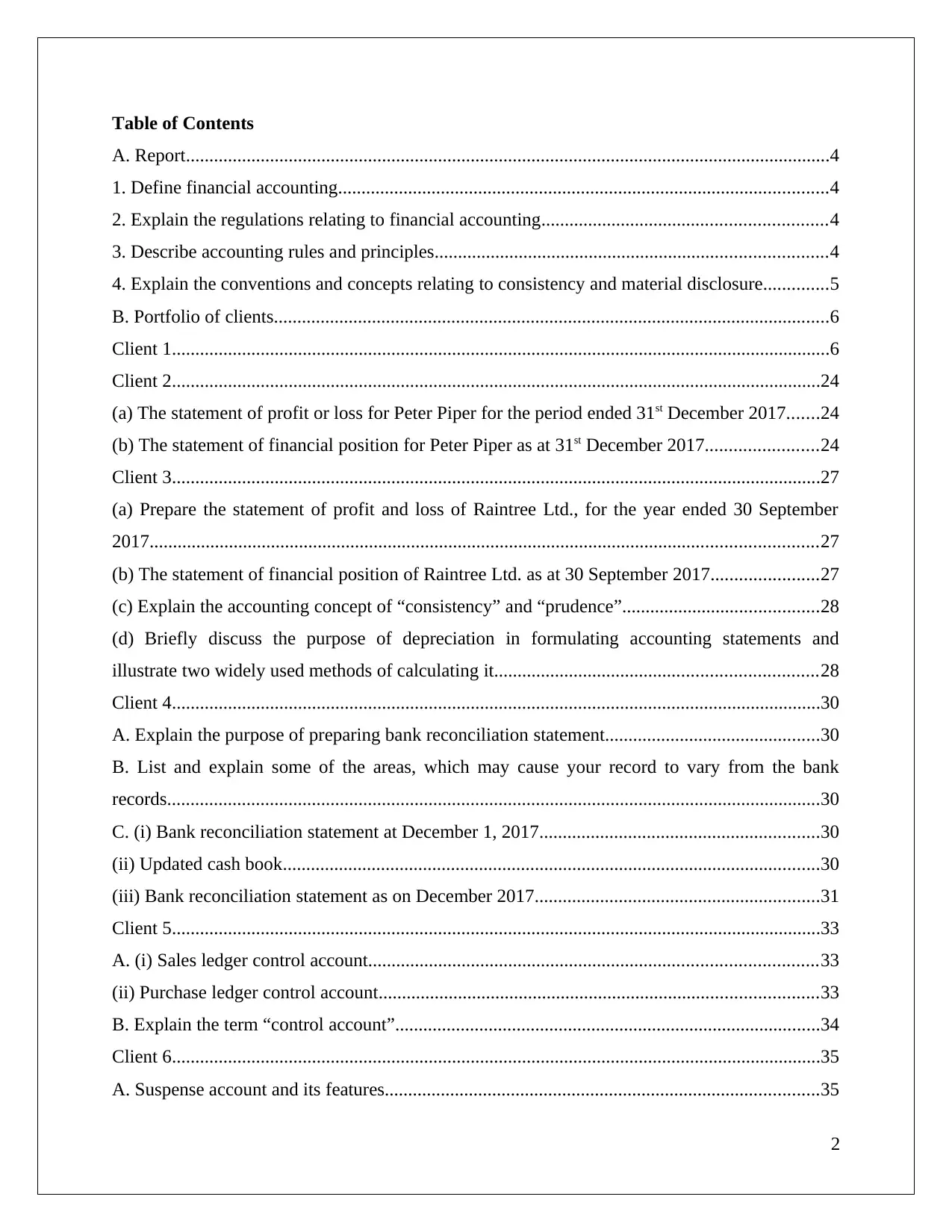
Table of Contents
A. Report..........................................................................................................................................4
1. Define financial accounting.........................................................................................................4
2. Explain the regulations relating to financial accounting.............................................................4
3. Describe accounting rules and principles....................................................................................4
4. Explain the conventions and concepts relating to consistency and material disclosure..............5
B. Portfolio of clients.......................................................................................................................6
Client 1.............................................................................................................................................6
Client 2...........................................................................................................................................24
(a) The statement of profit or loss for Peter Piper for the period ended 31st December 2017.......24
(b) The statement of financial position for Peter Piper as at 31st December 2017........................24
Client 3...........................................................................................................................................27
(a) Prepare the statement of profit and loss of Raintree Ltd., for the year ended 30 September
2017...............................................................................................................................................27
(b) The statement of financial position of Raintree Ltd. as at 30 September 2017.......................27
(c) Explain the accounting concept of “consistency” and “prudence”..........................................28
(d) Briefly discuss the purpose of depreciation in formulating accounting statements and
illustrate two widely used methods of calculating it.....................................................................28
Client 4...........................................................................................................................................30
A. Explain the purpose of preparing bank reconciliation statement..............................................30
B. List and explain some of the areas, which may cause your record to vary from the bank
records............................................................................................................................................30
C. (i) Bank reconciliation statement at December 1, 2017............................................................30
(ii) Updated cash book...................................................................................................................30
(iii) Bank reconciliation statement as on December 2017.............................................................31
Client 5...........................................................................................................................................33
A. (i) Sales ledger control account................................................................................................33
(ii) Purchase ledger control account..............................................................................................33
B. Explain the term “control account”...........................................................................................34
Client 6...........................................................................................................................................35
A. Suspense account and its features.............................................................................................35
2
A. Report..........................................................................................................................................4
1. Define financial accounting.........................................................................................................4
2. Explain the regulations relating to financial accounting.............................................................4
3. Describe accounting rules and principles....................................................................................4
4. Explain the conventions and concepts relating to consistency and material disclosure..............5
B. Portfolio of clients.......................................................................................................................6
Client 1.............................................................................................................................................6
Client 2...........................................................................................................................................24
(a) The statement of profit or loss for Peter Piper for the period ended 31st December 2017.......24
(b) The statement of financial position for Peter Piper as at 31st December 2017........................24
Client 3...........................................................................................................................................27
(a) Prepare the statement of profit and loss of Raintree Ltd., for the year ended 30 September
2017...............................................................................................................................................27
(b) The statement of financial position of Raintree Ltd. as at 30 September 2017.......................27
(c) Explain the accounting concept of “consistency” and “prudence”..........................................28
(d) Briefly discuss the purpose of depreciation in formulating accounting statements and
illustrate two widely used methods of calculating it.....................................................................28
Client 4...........................................................................................................................................30
A. Explain the purpose of preparing bank reconciliation statement..............................................30
B. List and explain some of the areas, which may cause your record to vary from the bank
records............................................................................................................................................30
C. (i) Bank reconciliation statement at December 1, 2017............................................................30
(ii) Updated cash book...................................................................................................................30
(iii) Bank reconciliation statement as on December 2017.............................................................31
Client 5...........................................................................................................................................33
A. (i) Sales ledger control account................................................................................................33
(ii) Purchase ledger control account..............................................................................................33
B. Explain the term “control account”...........................................................................................34
Client 6...........................................................................................................................................35
A. Suspense account and its features.............................................................................................35
2
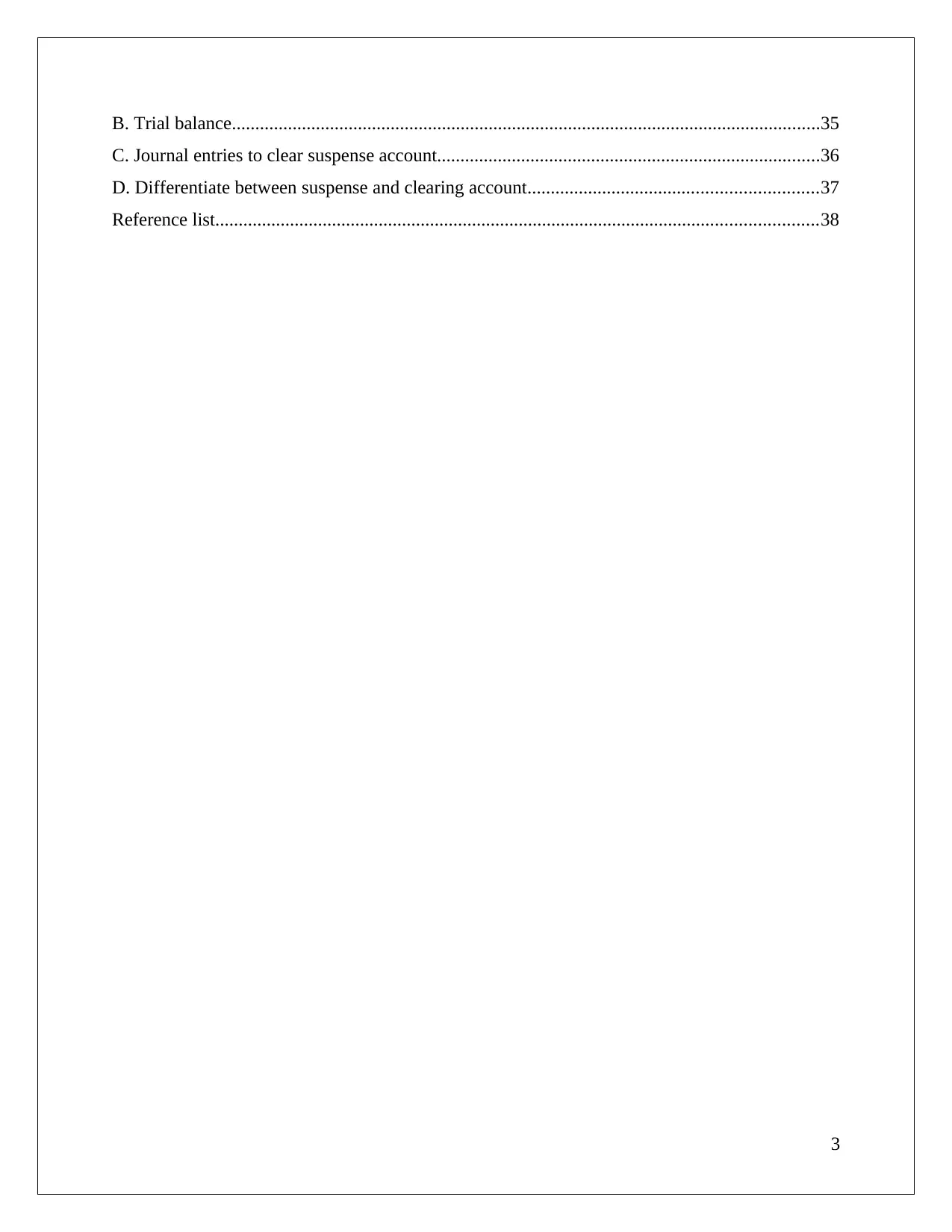
B. Trial balance..............................................................................................................................35
C. Journal entries to clear suspense account..................................................................................36
D. Differentiate between suspense and clearing account..............................................................37
Reference list.................................................................................................................................38
3
C. Journal entries to clear suspense account..................................................................................36
D. Differentiate between suspense and clearing account..............................................................37
Reference list.................................................................................................................................38
3
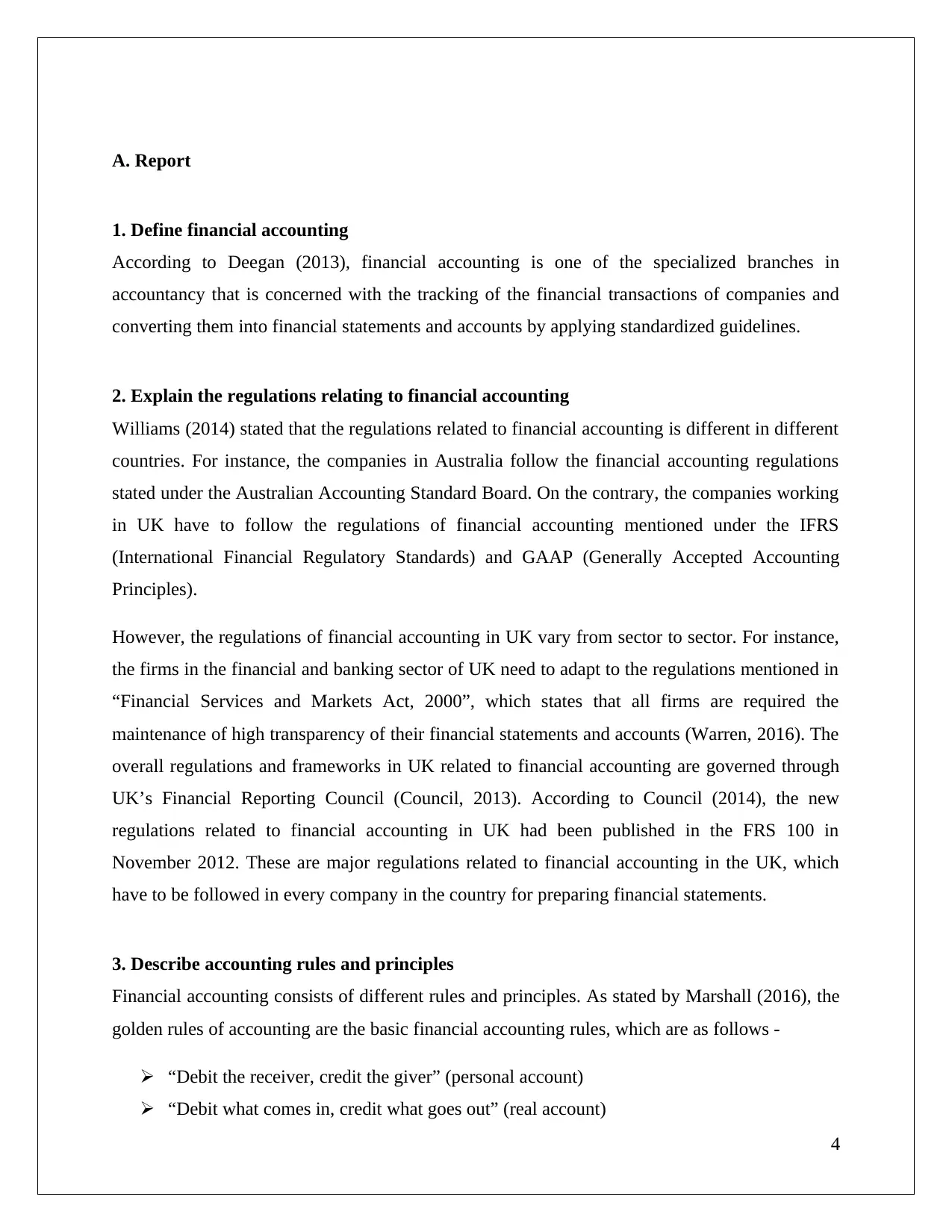
A. Report
1. Define financial accounting
According to Deegan (2013), financial accounting is one of the specialized branches in
accountancy that is concerned with the tracking of the financial transactions of companies and
converting them into financial statements and accounts by applying standardized guidelines.
2. Explain the regulations relating to financial accounting
Williams (2014) stated that the regulations related to financial accounting is different in different
countries. For instance, the companies in Australia follow the financial accounting regulations
stated under the Australian Accounting Standard Board. On the contrary, the companies working
in UK have to follow the regulations of financial accounting mentioned under the IFRS
(International Financial Regulatory Standards) and GAAP (Generally Accepted Accounting
Principles).
However, the regulations of financial accounting in UK vary from sector to sector. For instance,
the firms in the financial and banking sector of UK need to adapt to the regulations mentioned in
“Financial Services and Markets Act, 2000”, which states that all firms are required the
maintenance of high transparency of their financial statements and accounts (Warren, 2016). The
overall regulations and frameworks in UK related to financial accounting are governed through
UK’s Financial Reporting Council (Council, 2013). According to Council (2014), the new
regulations related to financial accounting in UK had been published in the FRS 100 in
November 2012. These are major regulations related to financial accounting in the UK, which
have to be followed in every company in the country for preparing financial statements.
3. Describe accounting rules and principles
Financial accounting consists of different rules and principles. As stated by Marshall (2016), the
golden rules of accounting are the basic financial accounting rules, which are as follows -
“Debit the receiver, credit the giver” (personal account)
“Debit what comes in, credit what goes out” (real account)
4
1. Define financial accounting
According to Deegan (2013), financial accounting is one of the specialized branches in
accountancy that is concerned with the tracking of the financial transactions of companies and
converting them into financial statements and accounts by applying standardized guidelines.
2. Explain the regulations relating to financial accounting
Williams (2014) stated that the regulations related to financial accounting is different in different
countries. For instance, the companies in Australia follow the financial accounting regulations
stated under the Australian Accounting Standard Board. On the contrary, the companies working
in UK have to follow the regulations of financial accounting mentioned under the IFRS
(International Financial Regulatory Standards) and GAAP (Generally Accepted Accounting
Principles).
However, the regulations of financial accounting in UK vary from sector to sector. For instance,
the firms in the financial and banking sector of UK need to adapt to the regulations mentioned in
“Financial Services and Markets Act, 2000”, which states that all firms are required the
maintenance of high transparency of their financial statements and accounts (Warren, 2016). The
overall regulations and frameworks in UK related to financial accounting are governed through
UK’s Financial Reporting Council (Council, 2013). According to Council (2014), the new
regulations related to financial accounting in UK had been published in the FRS 100 in
November 2012. These are major regulations related to financial accounting in the UK, which
have to be followed in every company in the country for preparing financial statements.
3. Describe accounting rules and principles
Financial accounting consists of different rules and principles. As stated by Marshall (2016), the
golden rules of accounting are the basic financial accounting rules, which are as follows -
“Debit the receiver, credit the giver” (personal account)
“Debit what comes in, credit what goes out” (real account)
4
Secure Best Marks with AI Grader
Need help grading? Try our AI Grader for instant feedback on your assignments.
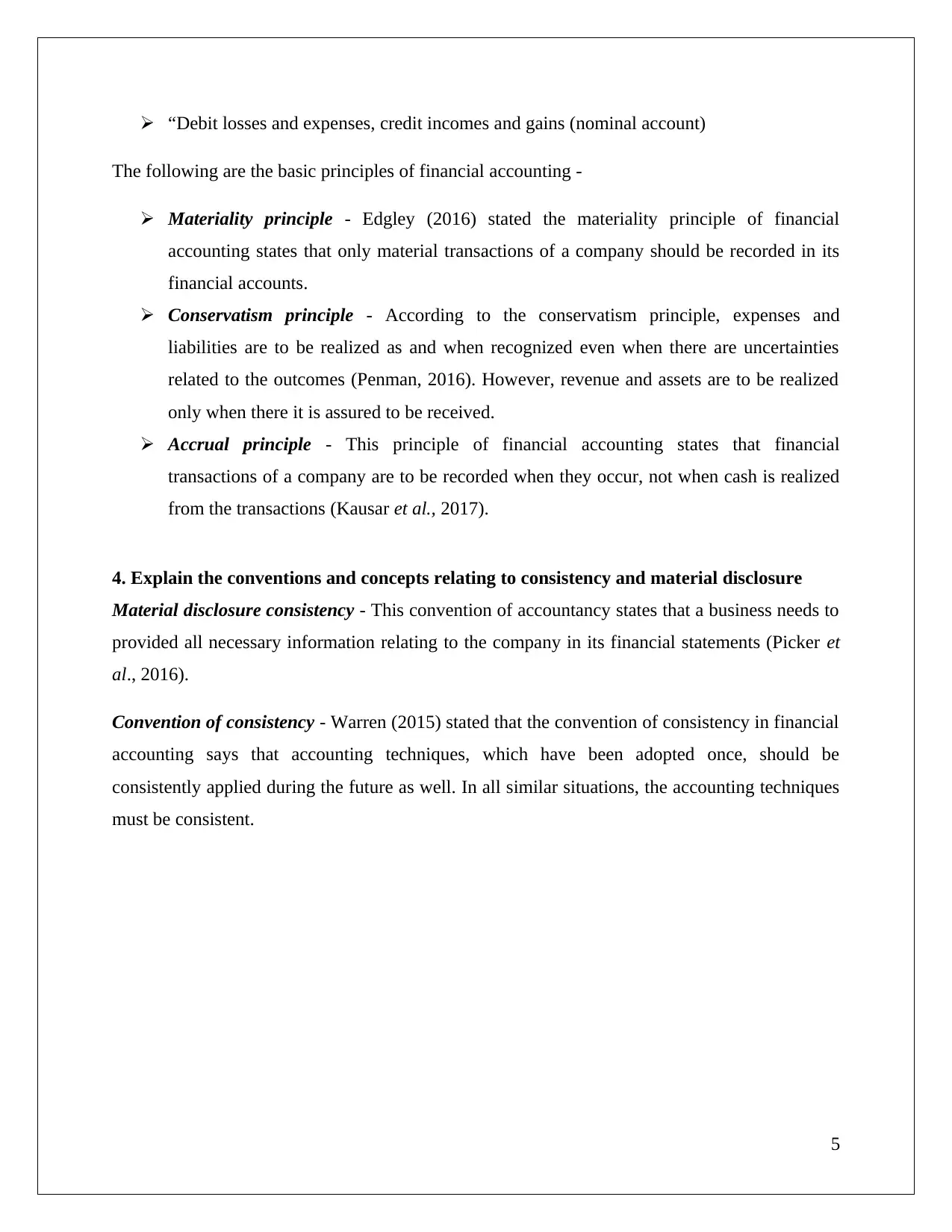
“Debit losses and expenses, credit incomes and gains (nominal account)
The following are the basic principles of financial accounting -
Materiality principle - Edgley (2016) stated the materiality principle of financial
accounting states that only material transactions of a company should be recorded in its
financial accounts.
Conservatism principle - According to the conservatism principle, expenses and
liabilities are to be realized as and when recognized even when there are uncertainties
related to the outcomes (Penman, 2016). However, revenue and assets are to be realized
only when there it is assured to be received.
Accrual principle - This principle of financial accounting states that financial
transactions of a company are to be recorded when they occur, not when cash is realized
from the transactions (Kausar et al., 2017).
4. Explain the conventions and concepts relating to consistency and material disclosure
Material disclosure consistency - This convention of accountancy states that a business needs to
provided all necessary information relating to the company in its financial statements (Picker et
al., 2016).
Convention of consistency - Warren (2015) stated that the convention of consistency in financial
accounting says that accounting techniques, which have been adopted once, should be
consistently applied during the future as well. In all similar situations, the accounting techniques
must be consistent.
5
The following are the basic principles of financial accounting -
Materiality principle - Edgley (2016) stated the materiality principle of financial
accounting states that only material transactions of a company should be recorded in its
financial accounts.
Conservatism principle - According to the conservatism principle, expenses and
liabilities are to be realized as and when recognized even when there are uncertainties
related to the outcomes (Penman, 2016). However, revenue and assets are to be realized
only when there it is assured to be received.
Accrual principle - This principle of financial accounting states that financial
transactions of a company are to be recorded when they occur, not when cash is realized
from the transactions (Kausar et al., 2017).
4. Explain the conventions and concepts relating to consistency and material disclosure
Material disclosure consistency - This convention of accountancy states that a business needs to
provided all necessary information relating to the company in its financial statements (Picker et
al., 2016).
Convention of consistency - Warren (2015) stated that the convention of consistency in financial
accounting says that accounting techniques, which have been adopted once, should be
consistently applied during the future as well. In all similar situations, the accounting techniques
must be consistent.
5
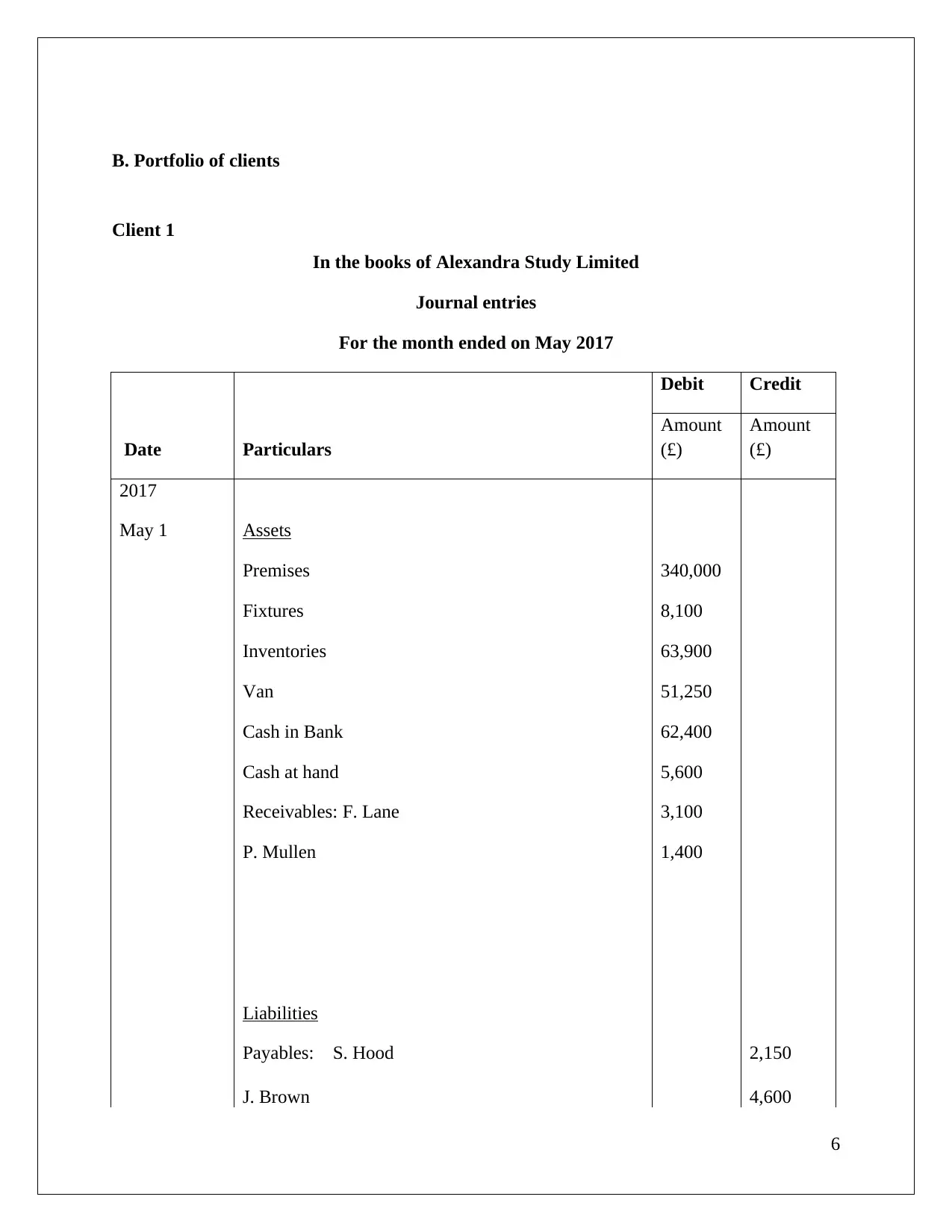
B. Portfolio of clients
Client 1
In the books of Alexandra Study Limited
Journal entries
For the month ended on May 2017
Date Particulars
Debit Credit
Amount
(£)
Amount
(£)
2017
May 1 Assets
Premises 340,000
Fixtures 8,100
Inventories 63,900
Van 51,250
Cash in Bank 62,400
Cash at hand 5,600
Receivables: F. Lane 3,100
P. Mullen 1,400
Liabilities
Payables: S. Hood 2,150
J. Brown 4,600
6
Client 1
In the books of Alexandra Study Limited
Journal entries
For the month ended on May 2017
Date Particulars
Debit Credit
Amount
(£)
Amount
(£)
2017
May 1 Assets
Premises 340,000
Fixtures 8,100
Inventories 63,900
Van 51,250
Cash in Bank 62,400
Cash at hand 5,600
Receivables: F. Lane 3,100
P. Mullen 1,400
Liabilities
Payables: S. Hood 2,150
J. Brown 4,600
6
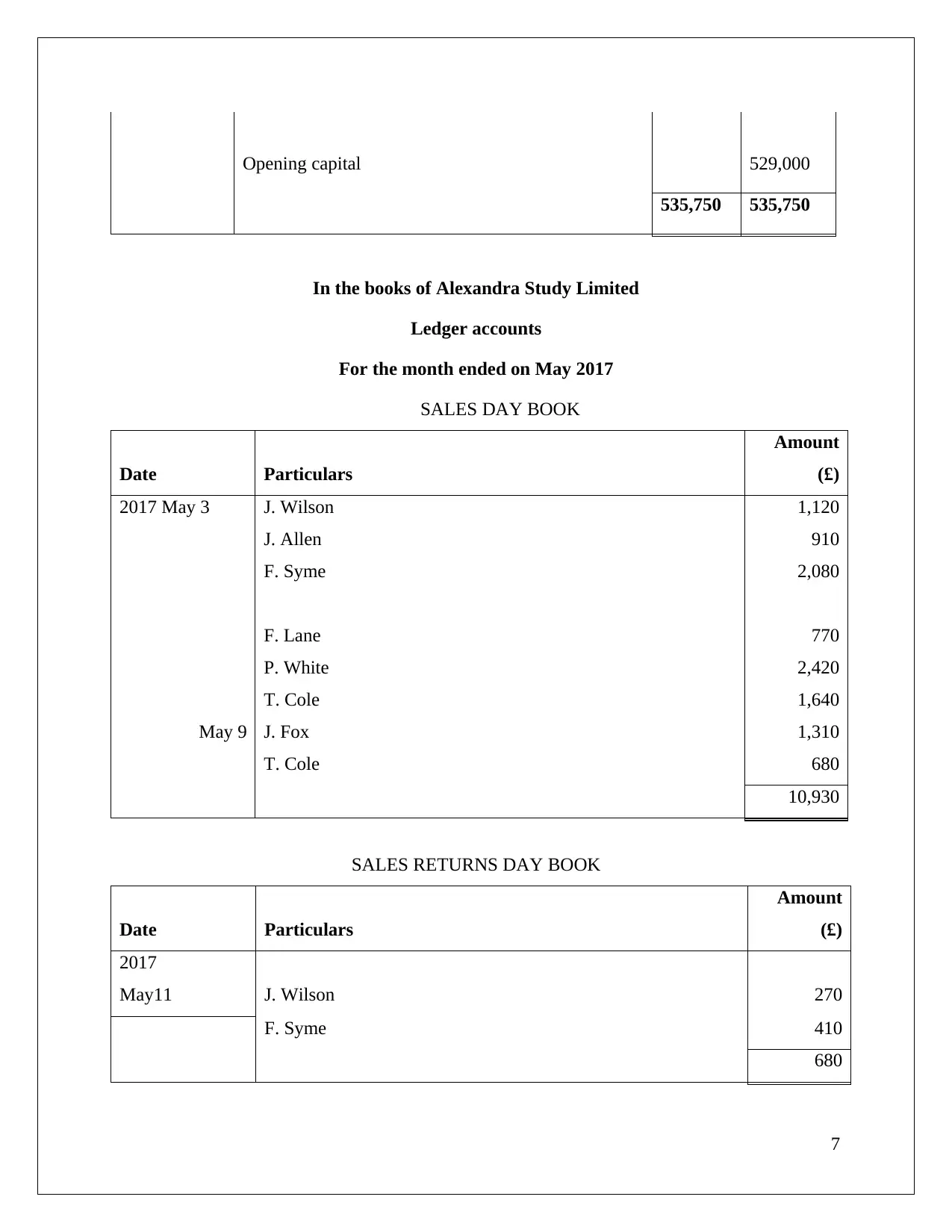
Opening capital 529,000
535,750 535,750
In the books of Alexandra Study Limited
Ledger accounts
For the month ended on May 2017
SALES DAY BOOK
Date Particulars
Amount
(£)
2017 May 3 J. Wilson 1,120
J. Allen 910
F. Syme 2,080
F. Lane 770
P. White 2,420
T. Cole 1,640
May 9 J. Fox 1,310
T. Cole 680
10,930
SALES RETURNS DAY BOOK
Date Particulars
Amount
(£)
2017
May11 J. Wilson 270
F. Syme 410
680
7
535,750 535,750
In the books of Alexandra Study Limited
Ledger accounts
For the month ended on May 2017
SALES DAY BOOK
Date Particulars
Amount
(£)
2017 May 3 J. Wilson 1,120
J. Allen 910
F. Syme 2,080
F. Lane 770
P. White 2,420
T. Cole 1,640
May 9 J. Fox 1,310
T. Cole 680
10,930
SALES RETURNS DAY BOOK
Date Particulars
Amount
(£)
2017
May11 J. Wilson 270
F. Syme 410
680
7
Paraphrase This Document
Need a fresh take? Get an instant paraphrase of this document with our AI Paraphraser
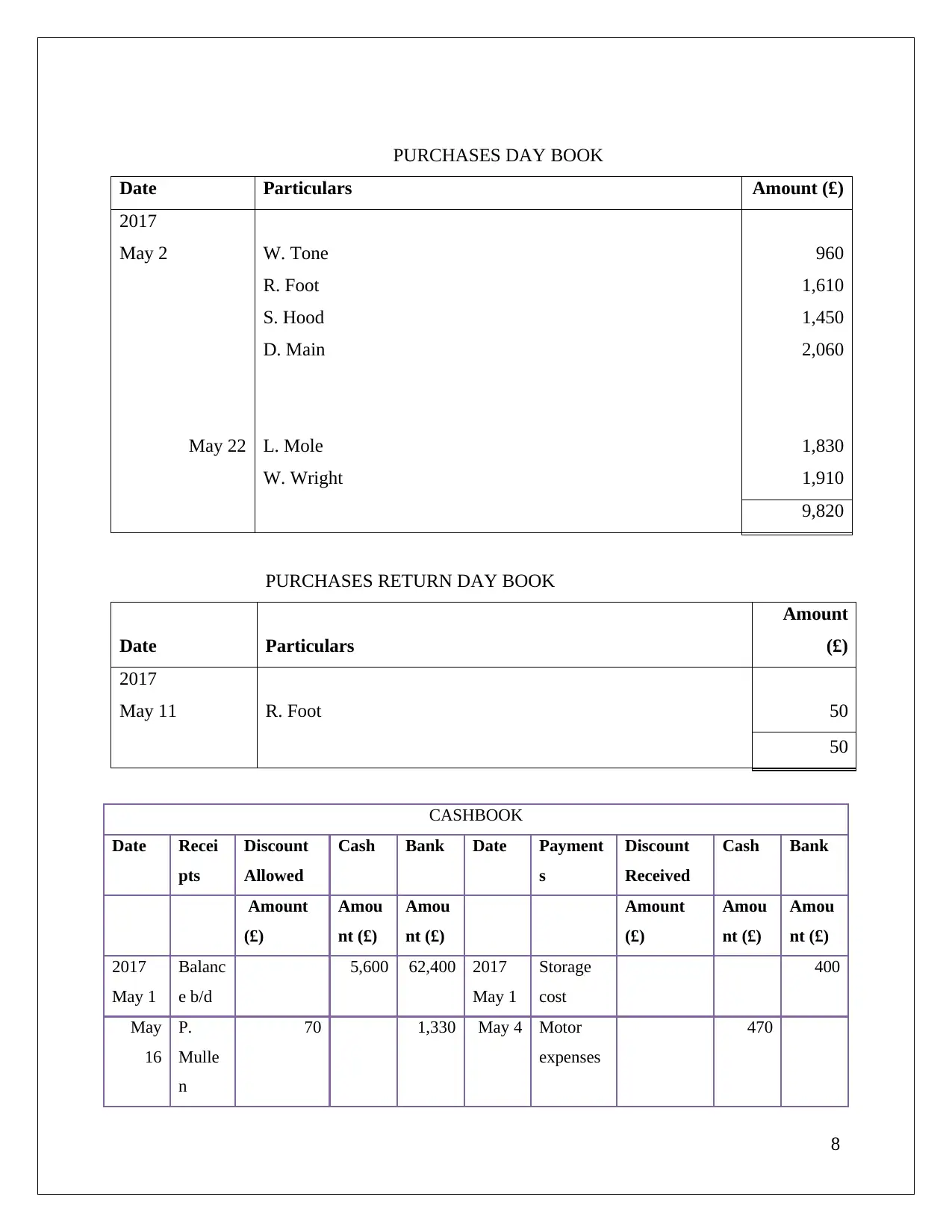
PURCHASES DAY BOOK
Date Particulars Amount (£)
2017
May 2 W. Tone 960
R. Foot 1,610
S. Hood 1,450
D. Main 2,060
May 22 L. Mole 1,830
W. Wright 1,910
9,820
PURCHASES RETURN DAY BOOK
Date Particulars
Amount
(£)
2017
May 11 R. Foot 50
50
CASHBOOK
Date Recei
pts
Discount
Allowed
Cash Bank Date Payment
s
Discount
Received
Cash Bank
Amount
(£)
Amou
nt (£)
Amou
nt (£)
Amount
(£)
Amou
nt (£)
Amou
nt (£)
2017
May 1
Balanc
e b/d
5,600 62,400 2017
May 1
Storage
cost
400
May
16
P.
Mulle
n
70 1,330 May 4 Motor
expenses
470
8
Date Particulars Amount (£)
2017
May 2 W. Tone 960
R. Foot 1,610
S. Hood 1,450
D. Main 2,060
May 22 L. Mole 1,830
W. Wright 1,910
9,820
PURCHASES RETURN DAY BOOK
Date Particulars
Amount
(£)
2017
May 11 R. Foot 50
50
CASHBOOK
Date Recei
pts
Discount
Allowed
Cash Bank Date Payment
s
Discount
Received
Cash Bank
Amount
(£)
Amou
nt (£)
Amou
nt (£)
Amount
(£)
Amou
nt (£)
Amou
nt (£)
2017
May 1
Balanc
e b/d
5,600 62,400 2017
May 1
Storage
cost
400
May
16
P.
Mulle
n
70 1,330 May 4 Motor
expenses
470
8
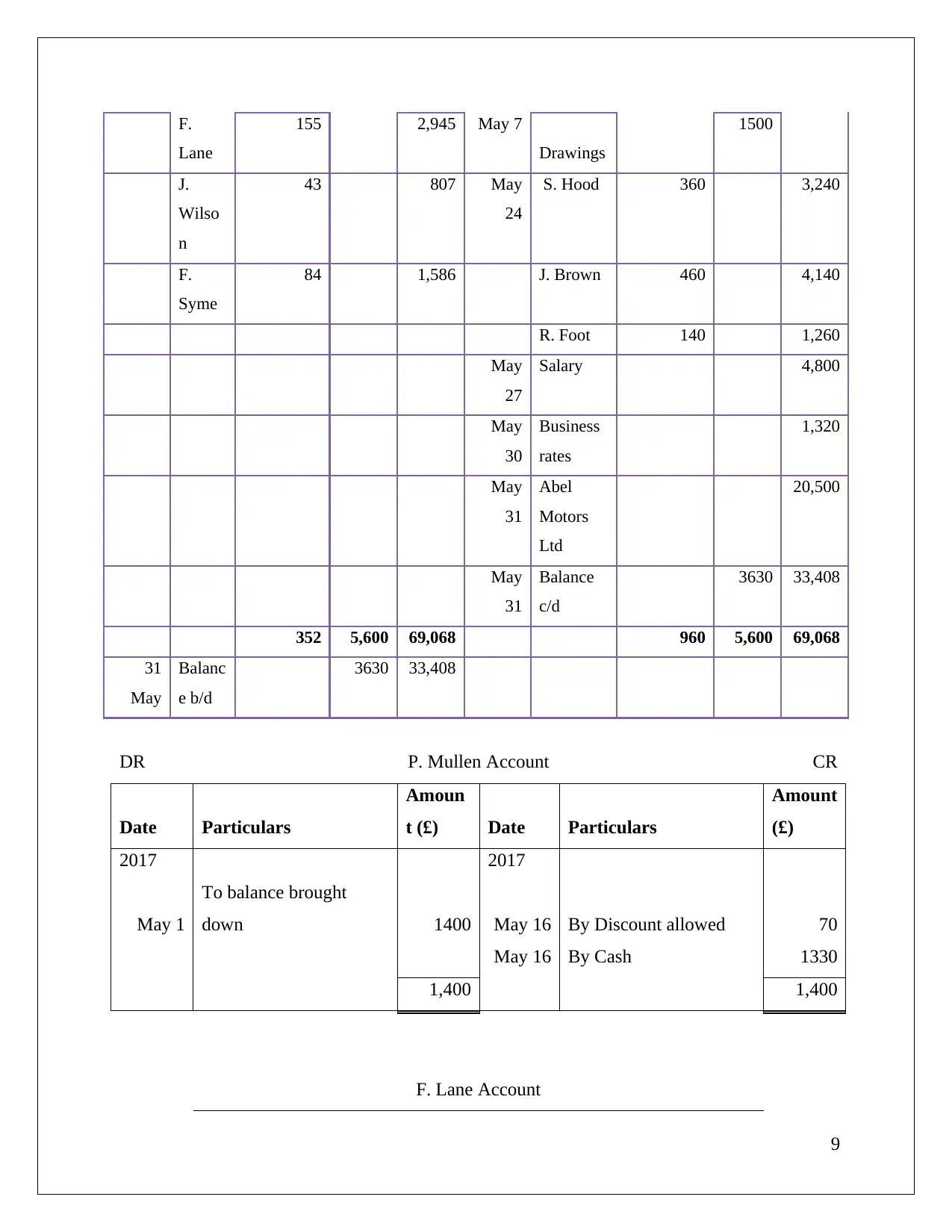
F.
Lane
155 2,945 May 7
Drawings
1500
J.
Wilso
n
43 807 May
24
S. Hood 360 3,240
F.
Syme
84 1,586 J. Brown 460 4,140
R. Foot 140 1,260
May
27
Salary 4,800
May
30
Business
rates
1,320
May
31
Abel
Motors
Ltd
20,500
May
31
Balance
c/d
3630 33,408
352 5,600 69,068 960 5,600 69,068
31
May
Balanc
e b/d
3630 33,408
DR P. Mullen Account CR
Date Particulars
Amoun
t (£) Date Particulars
Amount
(£)
2017 2017
May 1
To balance brought
down 1400 May 16 By Discount allowed 70
May 16 By Cash 1330
1,400 1,400
F. Lane Account
9
Lane
155 2,945 May 7
Drawings
1500
J.
Wilso
n
43 807 May
24
S. Hood 360 3,240
F.
Syme
84 1,586 J. Brown 460 4,140
R. Foot 140 1,260
May
27
Salary 4,800
May
30
Business
rates
1,320
May
31
Abel
Motors
Ltd
20,500
May
31
Balance
c/d
3630 33,408
352 5,600 69,068 960 5,600 69,068
31
May
Balanc
e b/d
3630 33,408
DR P. Mullen Account CR
Date Particulars
Amoun
t (£) Date Particulars
Amount
(£)
2017 2017
May 1
To balance brought
down 1400 May 16 By Discount allowed 70
May 16 By Cash 1330
1,400 1,400
F. Lane Account
9

DR CR
Date Particulars
Amoun
t (£) Date Particulars
Amount
(£)
2017
May
2017
May
1 Balance brought down 3100 16 By Discount 155
3 Sales 770 16 By Cash 2945
31
By Balance carried
forward 770
3,870 3,870
31
To Balance brought
down 770
DR J. Wilson Account CR
Date Particulars
Amoun
t (£) Date Particulars
Amount
(£)
2017
May
2017
May
3 To Sales 1,120 11 By Sales return 270
16 By Cash 807
16 By Discount 43
1,120 1,120
DR T. Cole Account CR
Date Particulars
Amoun
t (£) Date Particulars
Amount
(£)
2017
May
2017
May
3 To Sales 1,640 31
By Balance carried
forward 2,320
9 To Sales 680
10
Date Particulars
Amoun
t (£) Date Particulars
Amount
(£)
2017
May
2017
May
1 Balance brought down 3100 16 By Discount 155
3 Sales 770 16 By Cash 2945
31
By Balance carried
forward 770
3,870 3,870
31
To Balance brought
down 770
DR J. Wilson Account CR
Date Particulars
Amoun
t (£) Date Particulars
Amount
(£)
2017
May
2017
May
3 To Sales 1,120 11 By Sales return 270
16 By Cash 807
16 By Discount 43
1,120 1,120
DR T. Cole Account CR
Date Particulars
Amoun
t (£) Date Particulars
Amount
(£)
2017
May
2017
May
3 To Sales 1,640 31
By Balance carried
forward 2,320
9 To Sales 680
10
Secure Best Marks with AI Grader
Need help grading? Try our AI Grader for instant feedback on your assignments.
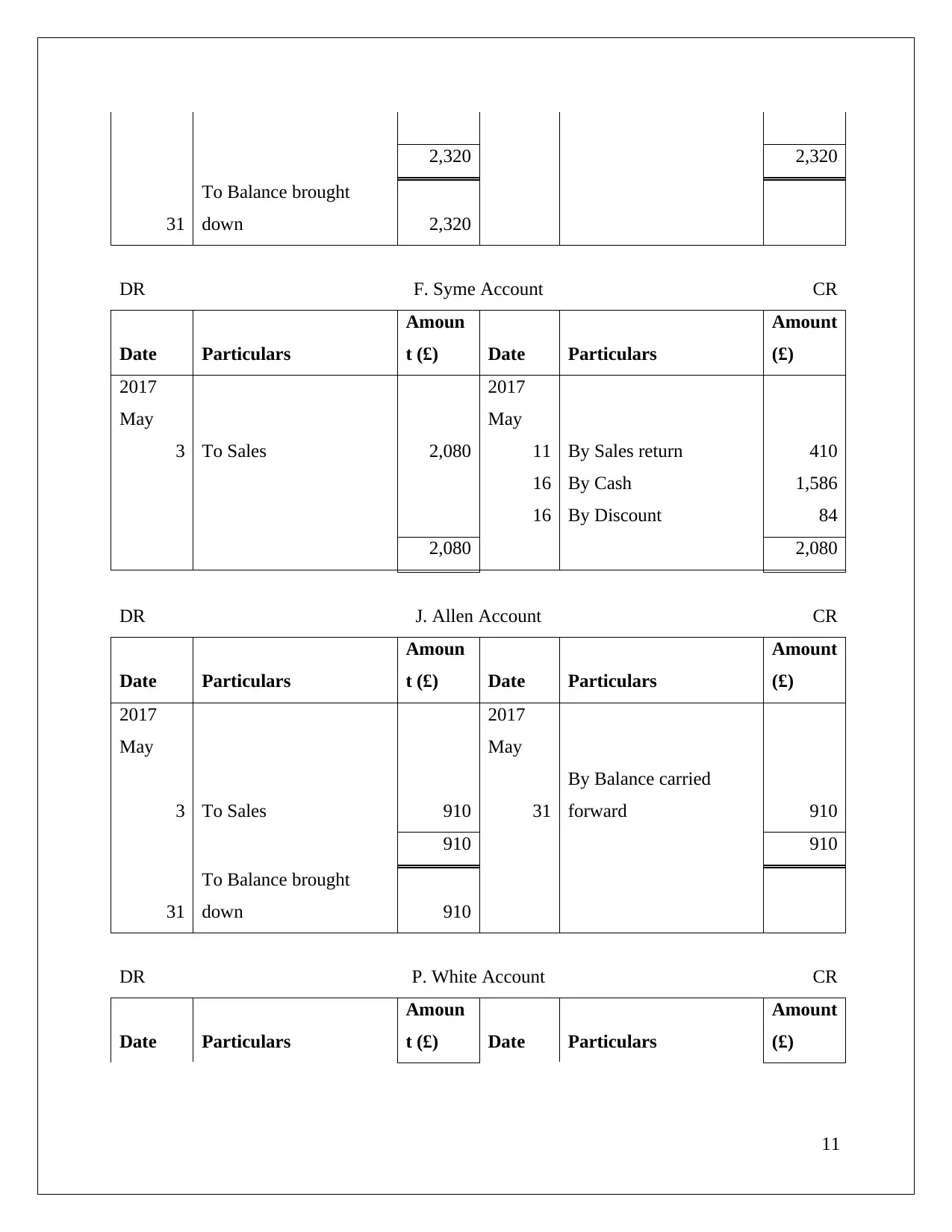
2,320 2,320
31
To Balance brought
down 2,320
DR F. Syme Account CR
Date Particulars
Amoun
t (£) Date Particulars
Amount
(£)
2017
May
2017
May
3 To Sales 2,080 11 By Sales return 410
16 By Cash 1,586
16 By Discount 84
2,080 2,080
DR J. Allen Account CR
Date Particulars
Amoun
t (£) Date Particulars
Amount
(£)
2017
May
2017
May
3 To Sales 910 31
By Balance carried
forward 910
910 910
31
To Balance brought
down 910
DR P. White Account CR
Date Particulars
Amoun
t (£) Date Particulars
Amount
(£)
11
31
To Balance brought
down 2,320
DR F. Syme Account CR
Date Particulars
Amoun
t (£) Date Particulars
Amount
(£)
2017
May
2017
May
3 To Sales 2,080 11 By Sales return 410
16 By Cash 1,586
16 By Discount 84
2,080 2,080
DR J. Allen Account CR
Date Particulars
Amoun
t (£) Date Particulars
Amount
(£)
2017
May
2017
May
3 To Sales 910 31
By Balance carried
forward 910
910 910
31
To Balance brought
down 910
DR P. White Account CR
Date Particulars
Amoun
t (£) Date Particulars
Amount
(£)
11

2017
May
2017
May
3 To Sales 2,420 31
By Balance carried
forward 2,420
2,420 2,420
31
To Balance brought
down 2,420
DR J. Fox Account CR
Date Particulars
Amoun
t (£) Date Particulars
Amount
(£)
2017
May
2017
May
9 To Sales 1,310 31
By Balance carried
forward 1,310
1,310 1,310
31
To Balance brought
down 1,310
DR S. Hood Account CR
Date Particulars
Amoun
t (£) Date Particulars
Amount
(£)
2017
May
2017
May
24 To Cash 3,240 1
By Balance brought
down 2,150
24 To Discount 360 2 By Purchases 1,450
3,600 3,600
12
May
2017
May
3 To Sales 2,420 31
By Balance carried
forward 2,420
2,420 2,420
31
To Balance brought
down 2,420
DR J. Fox Account CR
Date Particulars
Amoun
t (£) Date Particulars
Amount
(£)
2017
May
2017
May
9 To Sales 1,310 31
By Balance carried
forward 1,310
1,310 1,310
31
To Balance brought
down 1,310
DR S. Hood Account CR
Date Particulars
Amoun
t (£) Date Particulars
Amount
(£)
2017
May
2017
May
24 To Cash 3,240 1
By Balance brought
down 2,150
24 To Discount 360 2 By Purchases 1,450
3,600 3,600
12
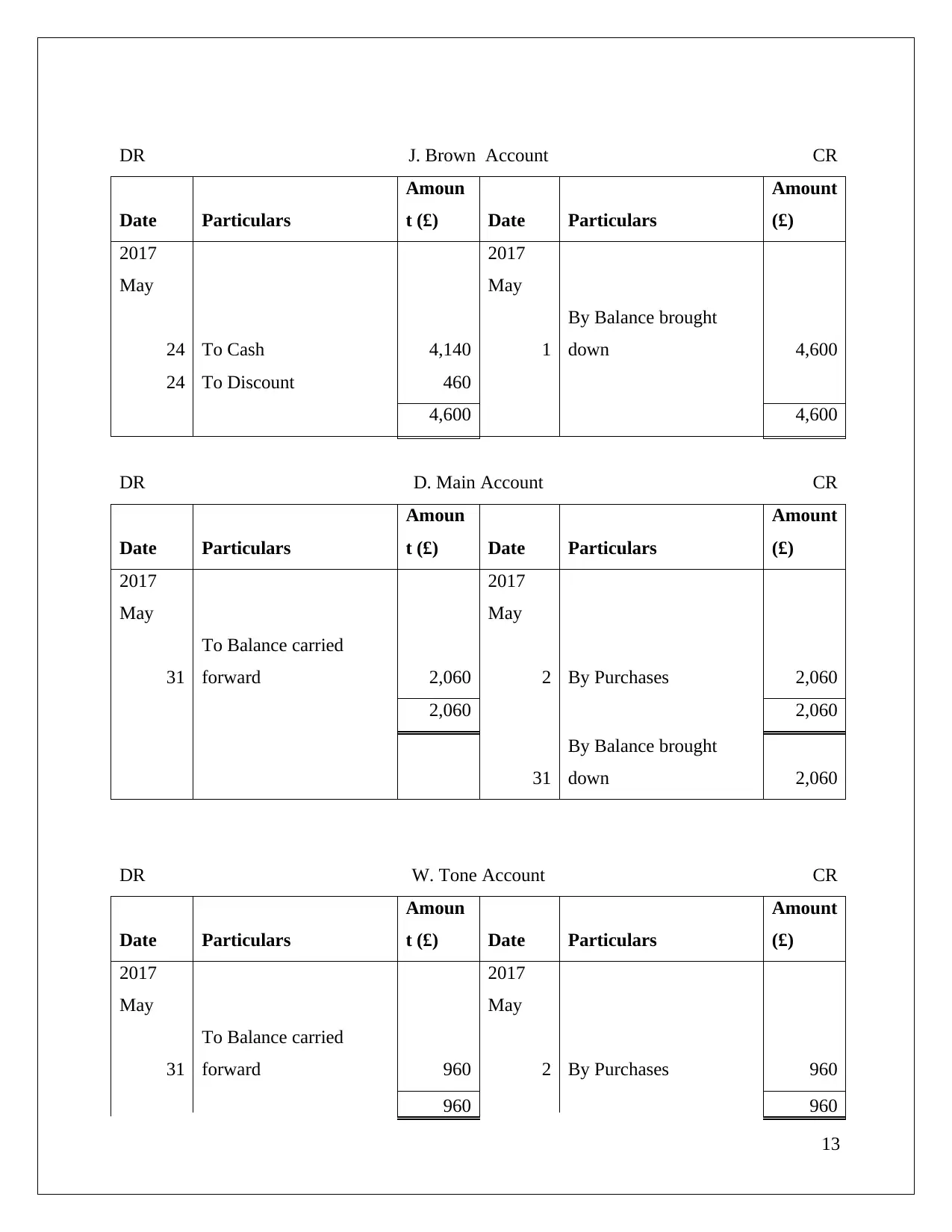
DR J. Brown Account CR
Date Particulars
Amoun
t (£) Date Particulars
Amount
(£)
2017
May
2017
May
24 To Cash 4,140 1
By Balance brought
down 4,600
24 To Discount 460
4,600 4,600
DR D. Main Account CR
Date Particulars
Amoun
t (£) Date Particulars
Amount
(£)
2017
May
2017
May
31
To Balance carried
forward 2,060 2 By Purchases 2,060
2,060 2,060
31
By Balance brought
down 2,060
DR W. Tone Account CR
Date Particulars
Amoun
t (£) Date Particulars
Amount
(£)
2017
May
2017
May
31
To Balance carried
forward 960 2 By Purchases 960
960 960
13
Date Particulars
Amoun
t (£) Date Particulars
Amount
(£)
2017
May
2017
May
24 To Cash 4,140 1
By Balance brought
down 4,600
24 To Discount 460
4,600 4,600
DR D. Main Account CR
Date Particulars
Amoun
t (£) Date Particulars
Amount
(£)
2017
May
2017
May
31
To Balance carried
forward 2,060 2 By Purchases 2,060
2,060 2,060
31
By Balance brought
down 2,060
DR W. Tone Account CR
Date Particulars
Amoun
t (£) Date Particulars
Amount
(£)
2017
May
2017
May
31
To Balance carried
forward 960 2 By Purchases 960
960 960
13
Paraphrase This Document
Need a fresh take? Get an instant paraphrase of this document with our AI Paraphraser
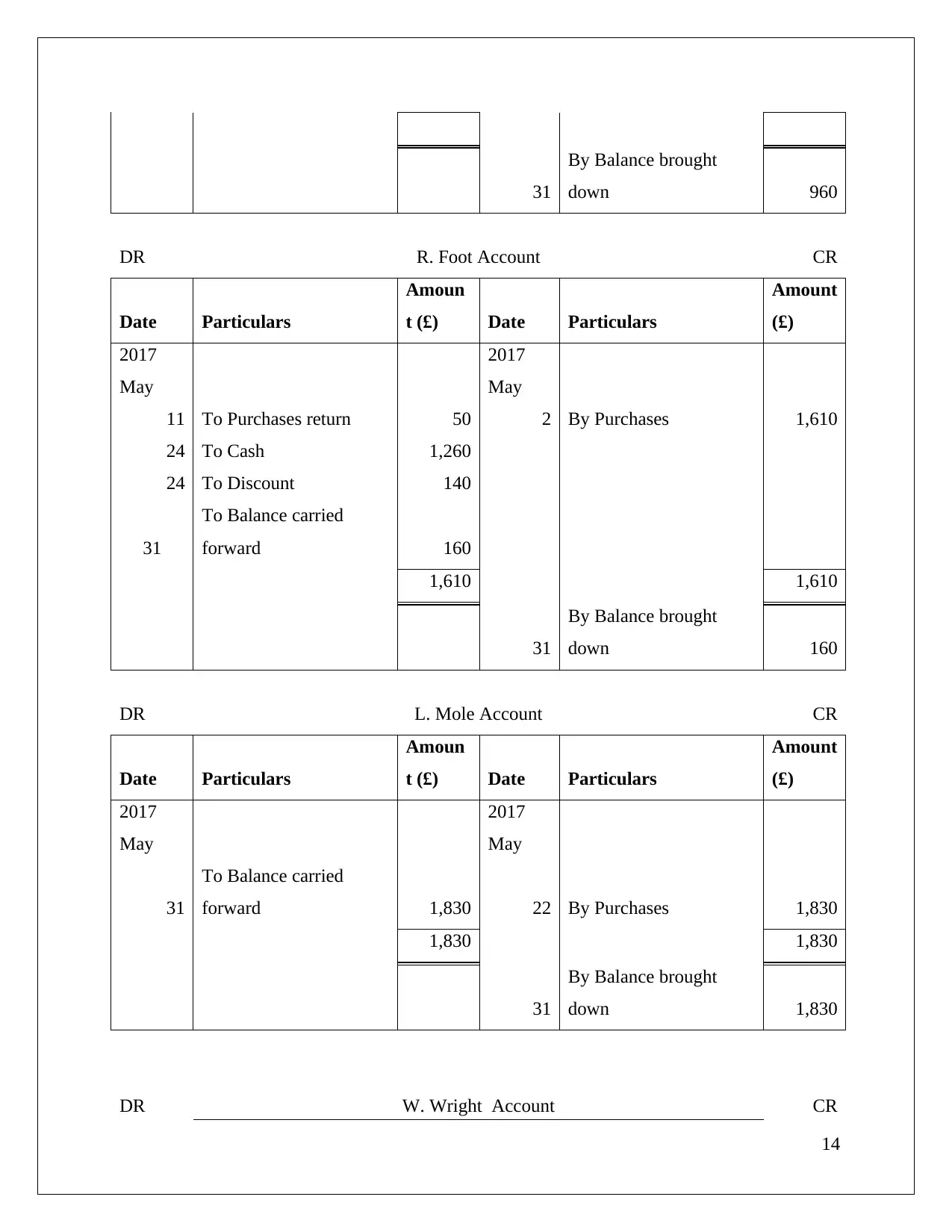
31
By Balance brought
down 960
DR R. Foot Account CR
Date Particulars
Amoun
t (£) Date Particulars
Amount
(£)
2017
May
2017
May
11 To Purchases return 50 2 By Purchases 1,610
24 To Cash 1,260
24 To Discount 140
31
To Balance carried
forward 160
1,610 1,610
31
By Balance brought
down 160
DR L. Mole Account CR
Date Particulars
Amoun
t (£) Date Particulars
Amount
(£)
2017
May
2017
May
31
To Balance carried
forward 1,830 22 By Purchases 1,830
1,830 1,830
31
By Balance brought
down 1,830
DR W. Wright Account CR
14
By Balance brought
down 960
DR R. Foot Account CR
Date Particulars
Amoun
t (£) Date Particulars
Amount
(£)
2017
May
2017
May
11 To Purchases return 50 2 By Purchases 1,610
24 To Cash 1,260
24 To Discount 140
31
To Balance carried
forward 160
1,610 1,610
31
By Balance brought
down 160
DR L. Mole Account CR
Date Particulars
Amoun
t (£) Date Particulars
Amount
(£)
2017
May
2017
May
31
To Balance carried
forward 1,830 22 By Purchases 1,830
1,830 1,830
31
By Balance brought
down 1,830
DR W. Wright Account CR
14
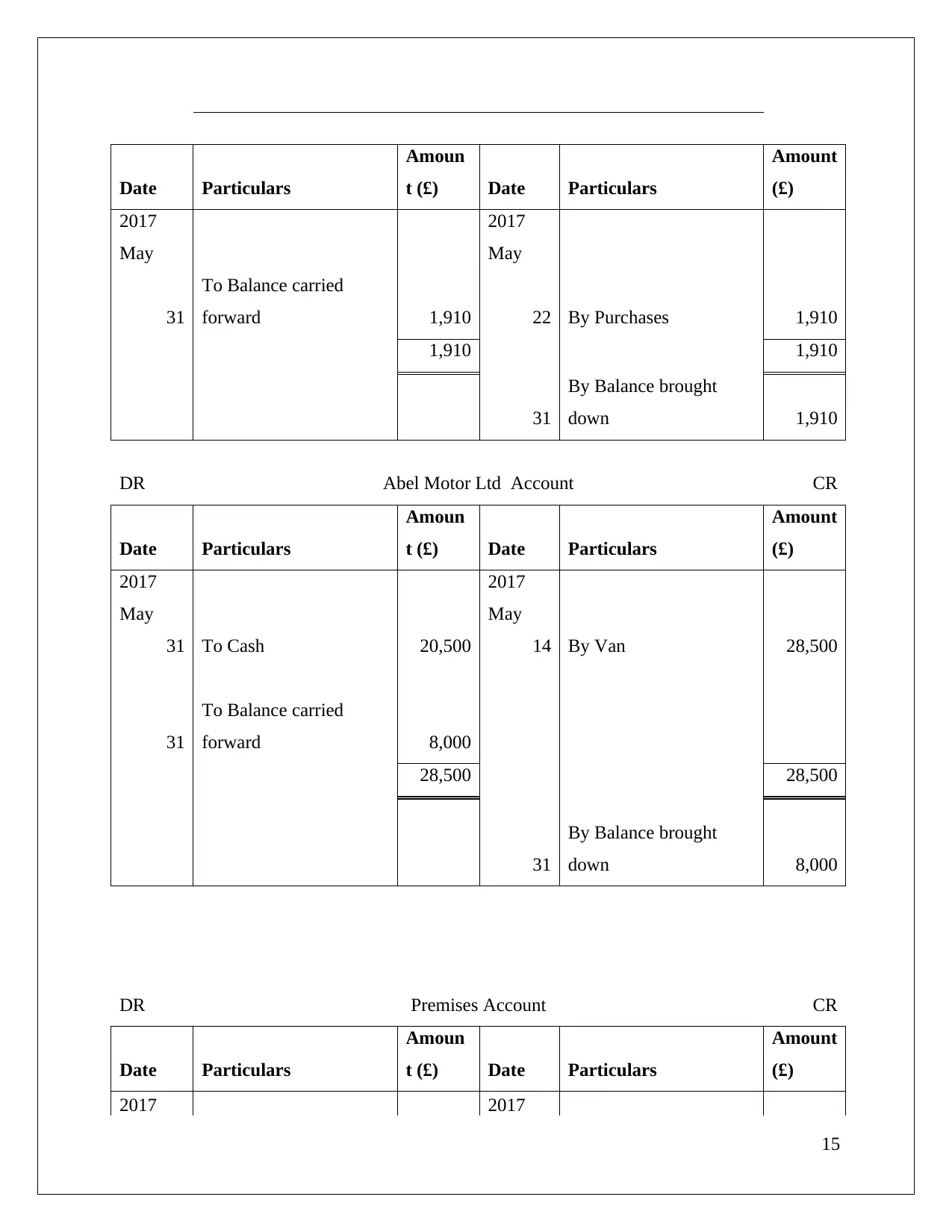
Date Particulars
Amoun
t (£) Date Particulars
Amount
(£)
2017
May
2017
May
31
To Balance carried
forward 1,910 22 By Purchases 1,910
1,910 1,910
31
By Balance brought
down 1,910
DR Abel Motor Ltd Account CR
Date Particulars
Amoun
t (£) Date Particulars
Amount
(£)
2017
May
2017
May
31 To Cash 20,500 14 By Van 28,500
31
To Balance carried
forward 8,000
28,500 28,500
31
By Balance brought
down 8,000
DR Premises Account CR
Date Particulars
Amoun
t (£) Date Particulars
Amount
(£)
2017 2017
15
Amoun
t (£) Date Particulars
Amount
(£)
2017
May
2017
May
31
To Balance carried
forward 1,910 22 By Purchases 1,910
1,910 1,910
31
By Balance brought
down 1,910
DR Abel Motor Ltd Account CR
Date Particulars
Amoun
t (£) Date Particulars
Amount
(£)
2017
May
2017
May
31 To Cash 20,500 14 By Van 28,500
31
To Balance carried
forward 8,000
28,500 28,500
31
By Balance brought
down 8,000
DR Premises Account CR
Date Particulars
Amoun
t (£) Date Particulars
Amount
(£)
2017 2017
15

May May
1
To Balance brought
down 340,000 31
By Balance carried
forward 340,000
340,000 340,000
31
To Balance brought
down 340,000
DR Van Account CR
Date Particulars
Amoun
t (£) Date Particulars
Amount
(£)
2017
May
2017
May
1
To Balance brought
down 51,250 31
By Balance carried
forward 79,750
14 To Abel Motors 28,500 79,750
31
To Balance brought
down 79,750
Fixtures Account
Date Particulars
Amoun
t (£) Date Particulars
Amount
(£)
2017
May
2017
May
1
To Balance brought
down 8,100 31
By Balance carried
forward 8,100
8,100 8,100
31
To Balance brought
down 8,100
16
1
To Balance brought
down 340,000 31
By Balance carried
forward 340,000
340,000 340,000
31
To Balance brought
down 340,000
DR Van Account CR
Date Particulars
Amoun
t (£) Date Particulars
Amount
(£)
2017
May
2017
May
1
To Balance brought
down 51,250 31
By Balance carried
forward 79,750
14 To Abel Motors 28,500 79,750
31
To Balance brought
down 79,750
Fixtures Account
Date Particulars
Amoun
t (£) Date Particulars
Amount
(£)
2017
May
2017
May
1
To Balance brought
down 8,100 31
By Balance carried
forward 8,100
8,100 8,100
31
To Balance brought
down 8,100
16
Secure Best Marks with AI Grader
Need help grading? Try our AI Grader for instant feedback on your assignments.
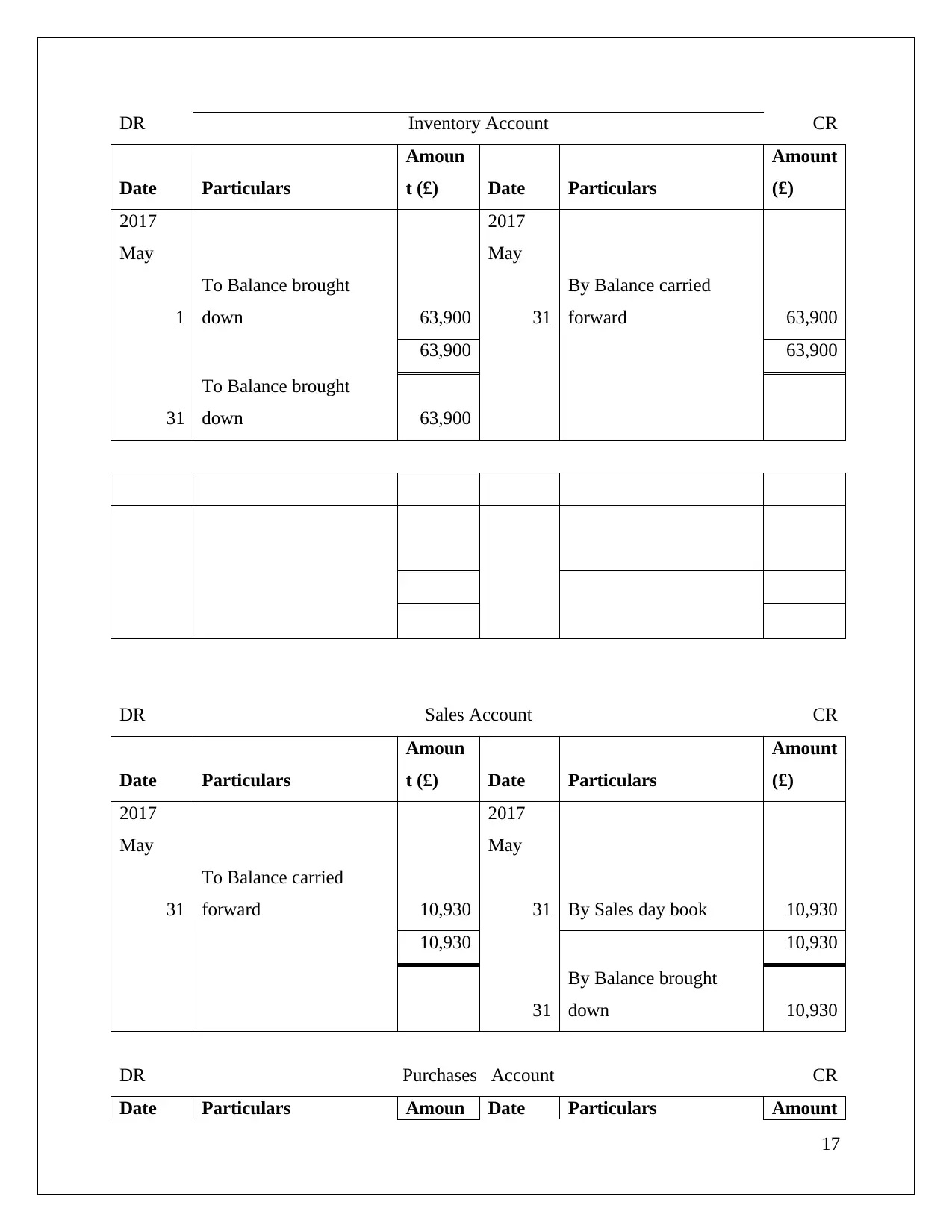
DR Inventory Account CR
Date Particulars
Amoun
t (£) Date Particulars
Amount
(£)
2017
May
2017
May
1
To Balance brought
down 63,900 31
By Balance carried
forward 63,900
63,900 63,900
31
To Balance brought
down 63,900
DR Sales Account CR
Date Particulars
Amoun
t (£) Date Particulars
Amount
(£)
2017
May
2017
May
31
To Balance carried
forward 10,930 31 By Sales day book 10,930
10,930 10,930
31
By Balance brought
down 10,930
DR Purchases Account CR
Date Particulars Amoun Date Particulars Amount
17
Date Particulars
Amoun
t (£) Date Particulars
Amount
(£)
2017
May
2017
May
1
To Balance brought
down 63,900 31
By Balance carried
forward 63,900
63,900 63,900
31
To Balance brought
down 63,900
DR Sales Account CR
Date Particulars
Amoun
t (£) Date Particulars
Amount
(£)
2017
May
2017
May
31
To Balance carried
forward 10,930 31 By Sales day book 10,930
10,930 10,930
31
By Balance brought
down 10,930
DR Purchases Account CR
Date Particulars Amoun Date Particulars Amount
17
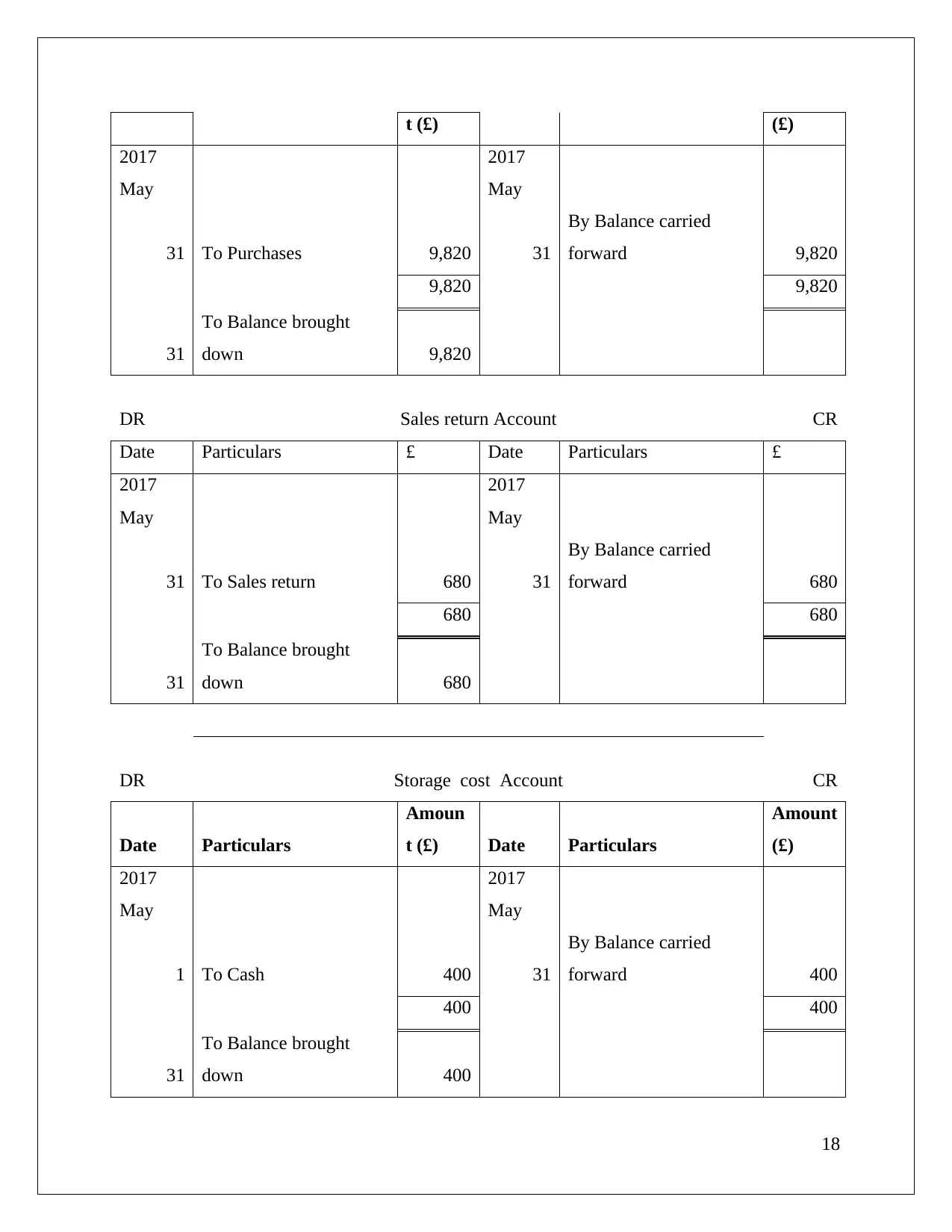
t (£) (£)
2017
May
2017
May
31 To Purchases 9,820 31
By Balance carried
forward 9,820
9,820 9,820
31
To Balance brought
down 9,820
DR Sales return Account CR
Date Particulars £ Date Particulars £
2017
May
2017
May
31 To Sales return 680 31
By Balance carried
forward 680
680 680
31
To Balance brought
down 680
DR Storage cost Account CR
Date Particulars
Amoun
t (£) Date Particulars
Amount
(£)
2017
May
2017
May
1 To Cash 400 31
By Balance carried
forward 400
400 400
31
To Balance brought
down 400
18
2017
May
2017
May
31 To Purchases 9,820 31
By Balance carried
forward 9,820
9,820 9,820
31
To Balance brought
down 9,820
DR Sales return Account CR
Date Particulars £ Date Particulars £
2017
May
2017
May
31 To Sales return 680 31
By Balance carried
forward 680
680 680
31
To Balance brought
down 680
DR Storage cost Account CR
Date Particulars
Amoun
t (£) Date Particulars
Amount
(£)
2017
May
2017
May
1 To Cash 400 31
By Balance carried
forward 400
400 400
31
To Balance brought
down 400
18
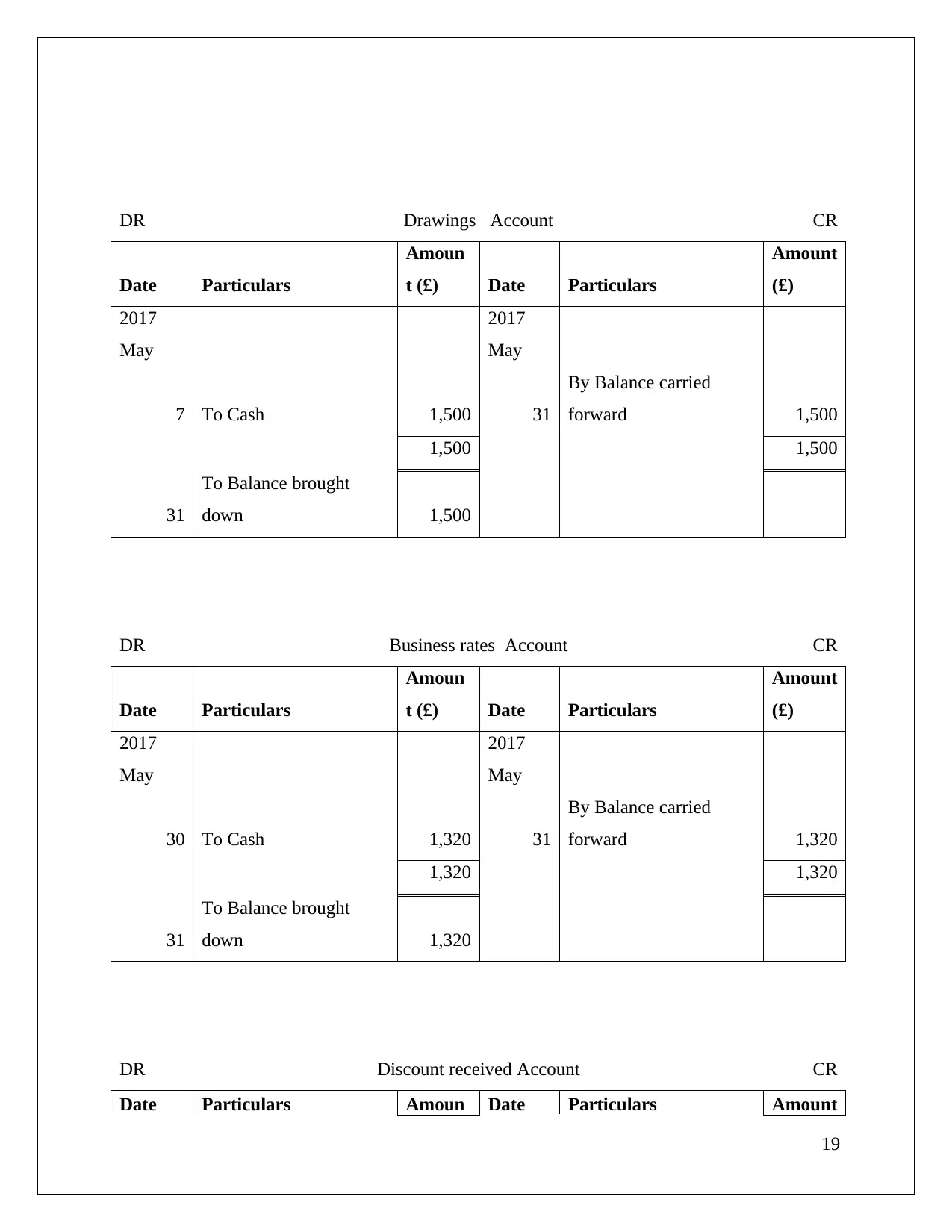
DR Drawings Account CR
Date Particulars
Amoun
t (£) Date Particulars
Amount
(£)
2017
May
2017
May
7 To Cash 1,500 31
By Balance carried
forward 1,500
1,500 1,500
31
To Balance brought
down 1,500
DR Business rates Account CR
Date Particulars
Amoun
t (£) Date Particulars
Amount
(£)
2017
May
2017
May
30 To Cash 1,320 31
By Balance carried
forward 1,320
1,320 1,320
31
To Balance brought
down 1,320
DR Discount received Account CR
Date Particulars Amoun Date Particulars Amount
19
Date Particulars
Amoun
t (£) Date Particulars
Amount
(£)
2017
May
2017
May
7 To Cash 1,500 31
By Balance carried
forward 1,500
1,500 1,500
31
To Balance brought
down 1,500
DR Business rates Account CR
Date Particulars
Amoun
t (£) Date Particulars
Amount
(£)
2017
May
2017
May
30 To Cash 1,320 31
By Balance carried
forward 1,320
1,320 1,320
31
To Balance brought
down 1,320
DR Discount received Account CR
Date Particulars Amoun Date Particulars Amount
19
Paraphrase This Document
Need a fresh take? Get an instant paraphrase of this document with our AI Paraphraser
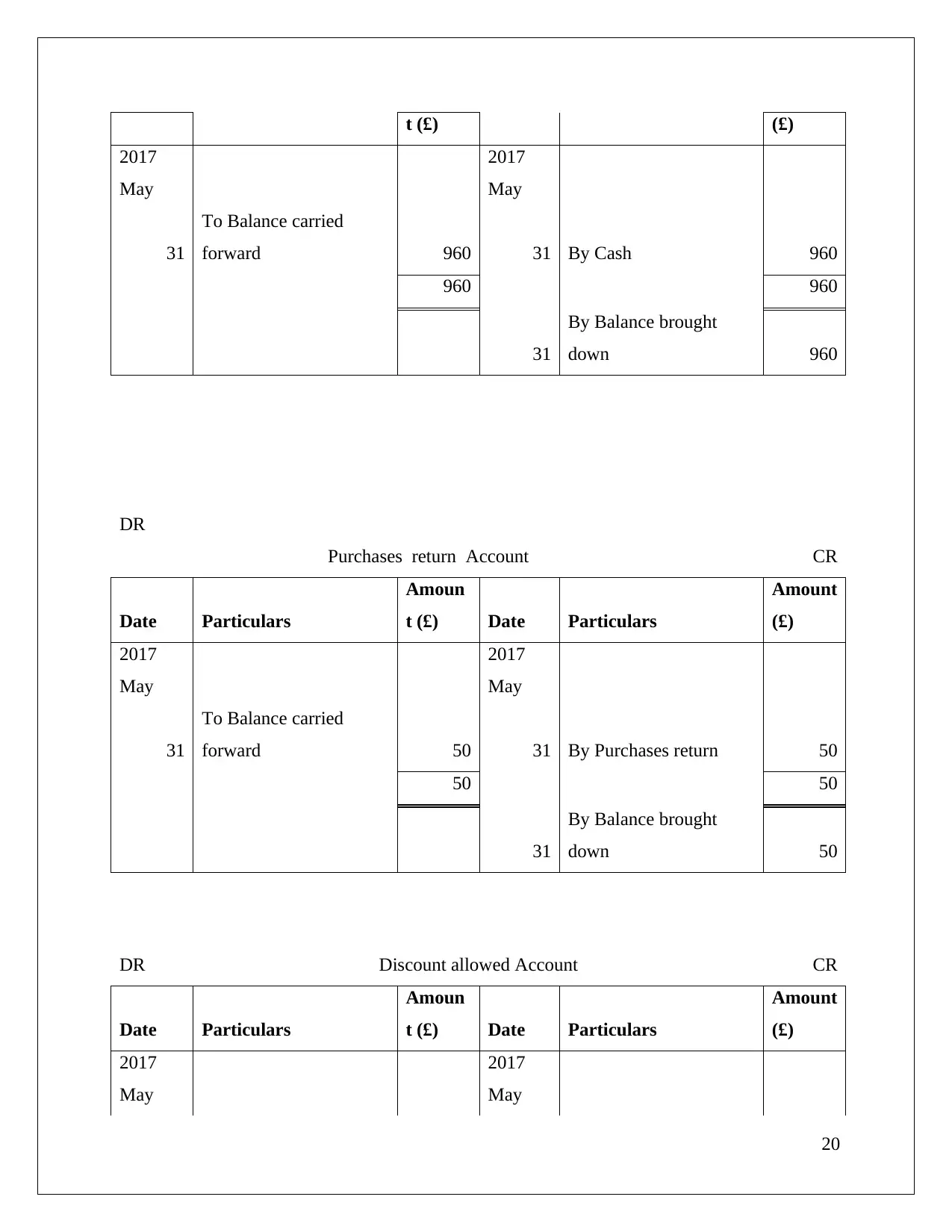
t (£) (£)
2017
May
2017
May
31
To Balance carried
forward 960 31 By Cash 960
960 960
31
By Balance brought
down 960
DR
Purchases return Account CR
Date Particulars
Amoun
t (£) Date Particulars
Amount
(£)
2017
May
2017
May
31
To Balance carried
forward 50 31 By Purchases return 50
50 50
31
By Balance brought
down 50
DR Discount allowed Account CR
Date Particulars
Amoun
t (£) Date Particulars
Amount
(£)
2017
May
2017
May
20
2017
May
2017
May
31
To Balance carried
forward 960 31 By Cash 960
960 960
31
By Balance brought
down 960
DR
Purchases return Account CR
Date Particulars
Amoun
t (£) Date Particulars
Amount
(£)
2017
May
2017
May
31
To Balance carried
forward 50 31 By Purchases return 50
50 50
31
By Balance brought
down 50
DR Discount allowed Account CR
Date Particulars
Amoun
t (£) Date Particulars
Amount
(£)
2017
May
2017
May
20
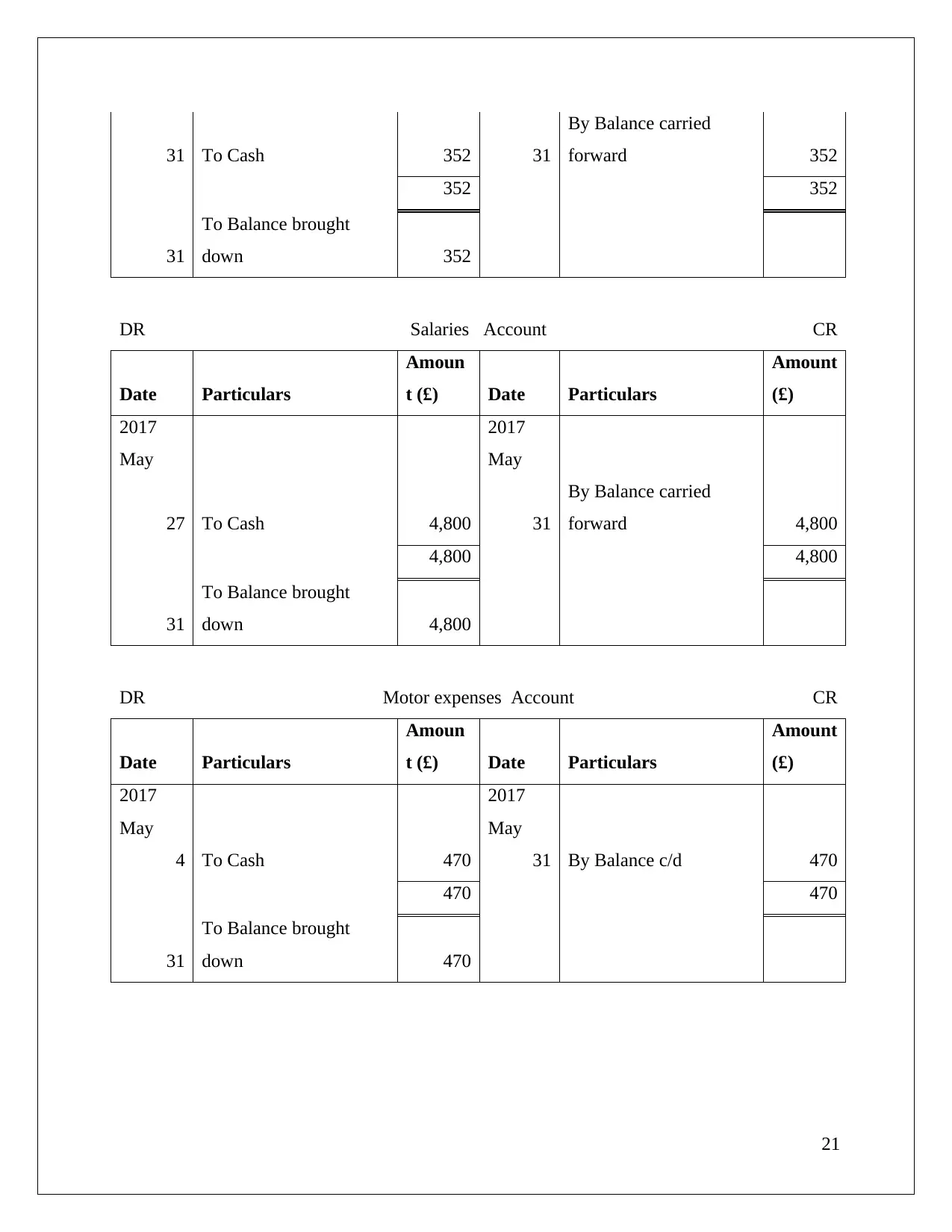
31 To Cash 352 31
By Balance carried
forward 352
352 352
31
To Balance brought
down 352
DR Salaries Account CR
Date Particulars
Amoun
t (£) Date Particulars
Amount
(£)
2017
May
2017
May
27 To Cash 4,800 31
By Balance carried
forward 4,800
4,800 4,800
31
To Balance brought
down 4,800
DR Motor expenses Account CR
Date Particulars
Amoun
t (£) Date Particulars
Amount
(£)
2017
May
2017
May
4 To Cash 470 31 By Balance c/d 470
470 470
31
To Balance brought
down 470
21
By Balance carried
forward 352
352 352
31
To Balance brought
down 352
DR Salaries Account CR
Date Particulars
Amoun
t (£) Date Particulars
Amount
(£)
2017
May
2017
May
27 To Cash 4,800 31
By Balance carried
forward 4,800
4,800 4,800
31
To Balance brought
down 4,800
DR Motor expenses Account CR
Date Particulars
Amoun
t (£) Date Particulars
Amount
(£)
2017
May
2017
May
4 To Cash 470 31 By Balance c/d 470
470 470
31
To Balance brought
down 470
21

In the books of Alexandra Study
Trial Balance as on 31st May 2017
Debit (Dr) Credit (CR)
Particulars
Amount (£) Amount (£)
Premises 340,000
Van 79,750
Inventories 63,900
Purchase 9,820
Purchases return 50
Fixtures 8,100
Sales 10,930
Capital 529,000
Sales return 680
Discounts received 960
Business rate 1,320
Motor expense 470
Salaries and wages 4,800
Payable: D. Main 2,060
Abel Motors Ltd 8,000
L. Mole 1,830
R. Foot 160
W. Wright 1,910
W. Tone 960
Drawing 1,500
Discounts allowed 352
Receivable: F. Lane 770
P. White 2,420
J. Allen 910
22
Trial Balance as on 31st May 2017
Debit (Dr) Credit (CR)
Particulars
Amount (£) Amount (£)
Premises 340,000
Van 79,750
Inventories 63,900
Purchase 9,820
Purchases return 50
Fixtures 8,100
Sales 10,930
Capital 529,000
Sales return 680
Discounts received 960
Business rate 1,320
Motor expense 470
Salaries and wages 4,800
Payable: D. Main 2,060
Abel Motors Ltd 8,000
L. Mole 1,830
R. Foot 160
W. Wright 1,910
W. Tone 960
Drawing 1,500
Discounts allowed 352
Receivable: F. Lane 770
P. White 2,420
J. Allen 910
22
Secure Best Marks with AI Grader
Need help grading? Try our AI Grader for instant feedback on your assignments.
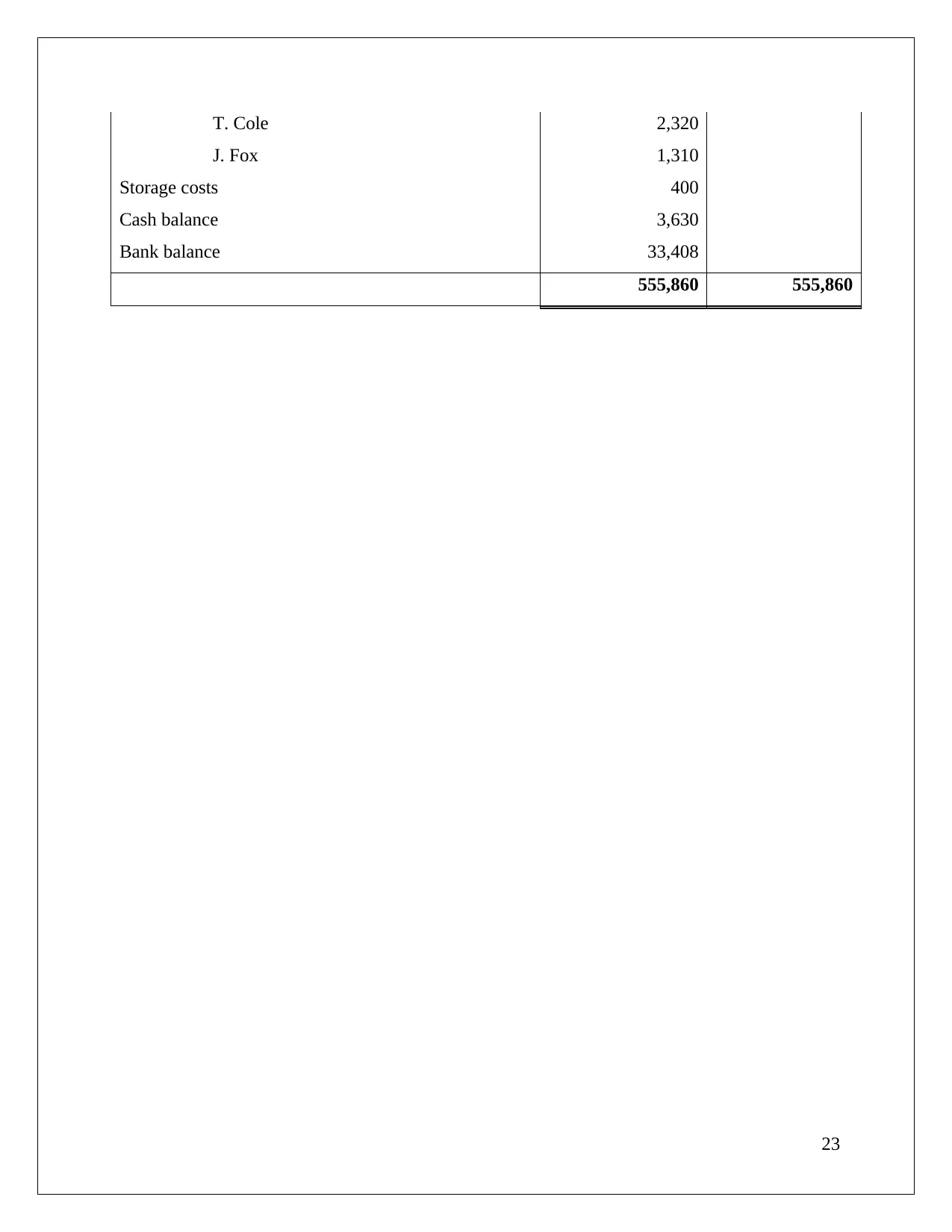
T. Cole 2,320
J. Fox 1,310
Storage costs 400
Cash balance 3,630
Bank balance 33,408
555,860 555,860
23
J. Fox 1,310
Storage costs 400
Cash balance 3,630
Bank balance 33,408
555,860 555,860
23

Client 2
(a) The statement of profit or loss for Peter Piper for the period ended 31st December 2017
Particulars Amount (£) Amount (£) Amount (£)
Revenue from operations 1,215,000
Less: Cost of goods sold
Opening stock 82,200
(+) Purchase 778,800
861,000
(-) Closing stock (101,640) (759,360)
Gross Profit 455,640
Less: Operational Expenses
Salaries and wages 177,500
(+) Accrued salaries and wages 1,220 178,720
Administrative Costs 17,650
Motor Car Expenses 87,400
Heat and light Expenses 4,950
Advertising Expenses 13,280
(-) Prepaid Advertisement expenses (8,470) 4,810
Depreciation:
Equipment 17,250
Motor Vehicles 2,800
Premises 5,400 25,450 (318,980)
EBIT (Net profit or PAT) 136,660
(b) The statement of financial position for Peter Piper as at 31st December 2017
Particulars Amount (£) Amount (£) Amount (£)
Cost Account Net
24
(a) The statement of profit or loss for Peter Piper for the period ended 31st December 2017
Particulars Amount (£) Amount (£) Amount (£)
Revenue from operations 1,215,000
Less: Cost of goods sold
Opening stock 82,200
(+) Purchase 778,800
861,000
(-) Closing stock (101,640) (759,360)
Gross Profit 455,640
Less: Operational Expenses
Salaries and wages 177,500
(+) Accrued salaries and wages 1,220 178,720
Administrative Costs 17,650
Motor Car Expenses 87,400
Heat and light Expenses 4,950
Advertising Expenses 13,280
(-) Prepaid Advertisement expenses (8,470) 4,810
Depreciation:
Equipment 17,250
Motor Vehicles 2,800
Premises 5,400 25,450 (318,980)
EBIT (Net profit or PAT) 136,660
(b) The statement of financial position for Peter Piper as at 31st December 2017
Particulars Amount (£) Amount (£) Amount (£)
Cost Account Net
24
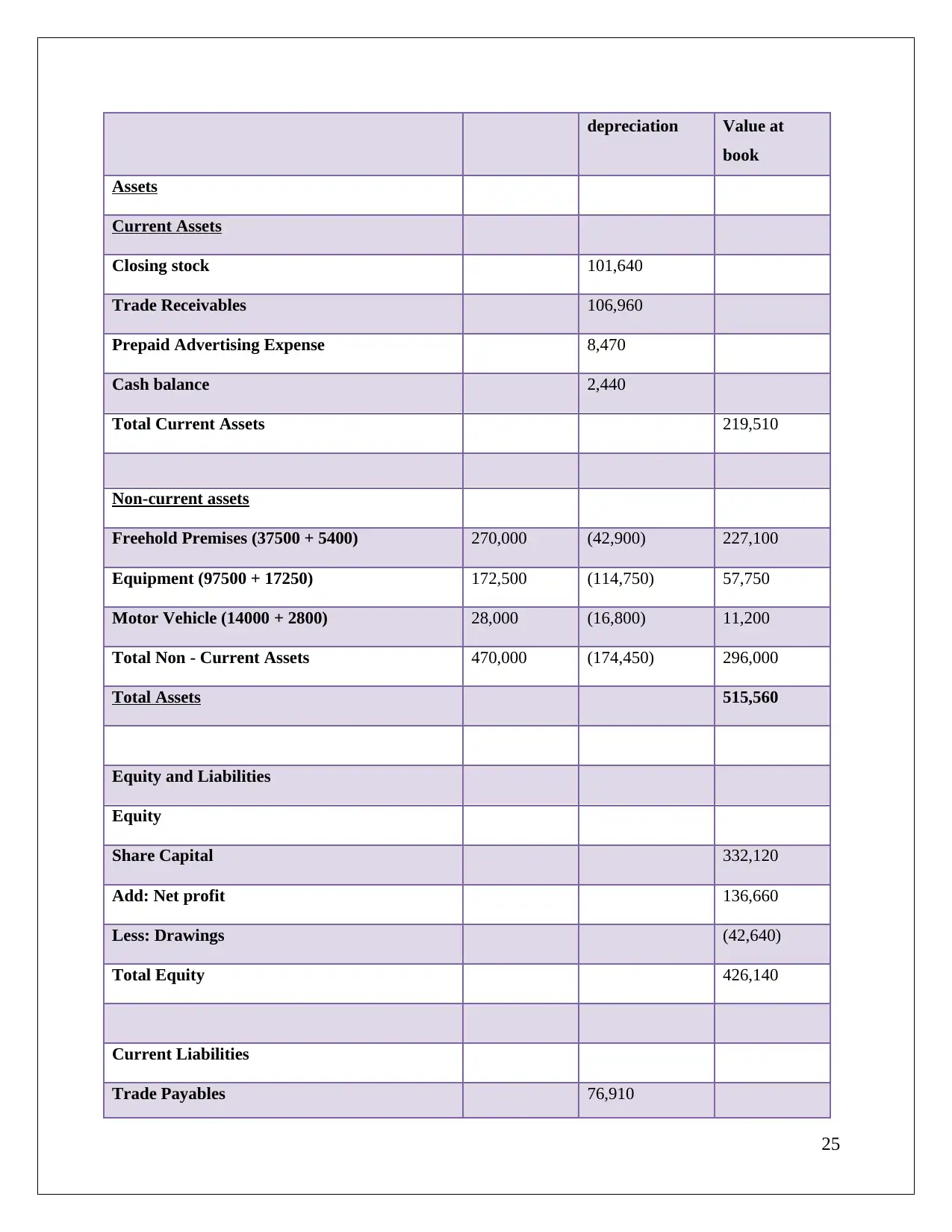
depreciation Value at
book
Assets
Current Assets
Closing stock 101,640
Trade Receivables 106,960
Prepaid Advertising Expense 8,470
Cash balance 2,440
Total Current Assets 219,510
Non-current assets
Freehold Premises (37500 + 5400) 270,000 (42,900) 227,100
Equipment (97500 + 17250) 172,500 (114,750) 57,750
Motor Vehicle (14000 + 2800) 28,000 (16,800) 11,200
Total Non - Current Assets 470,000 (174,450) 296,000
Total Assets 515,560
Equity and Liabilities
Equity
Share Capital 332,120
Add: Net profit 136,660
Less: Drawings (42,640)
Total Equity 426,140
Current Liabilities
Trade Payables 76,910
25
book
Assets
Current Assets
Closing stock 101,640
Trade Receivables 106,960
Prepaid Advertising Expense 8,470
Cash balance 2,440
Total Current Assets 219,510
Non-current assets
Freehold Premises (37500 + 5400) 270,000 (42,900) 227,100
Equipment (97500 + 17250) 172,500 (114,750) 57,750
Motor Vehicle (14000 + 2800) 28,000 (16,800) 11,200
Total Non - Current Assets 470,000 (174,450) 296,000
Total Assets 515,560
Equity and Liabilities
Equity
Share Capital 332,120
Add: Net profit 136,660
Less: Drawings (42,640)
Total Equity 426,140
Current Liabilities
Trade Payables 76,910
25
Paraphrase This Document
Need a fresh take? Get an instant paraphrase of this document with our AI Paraphraser
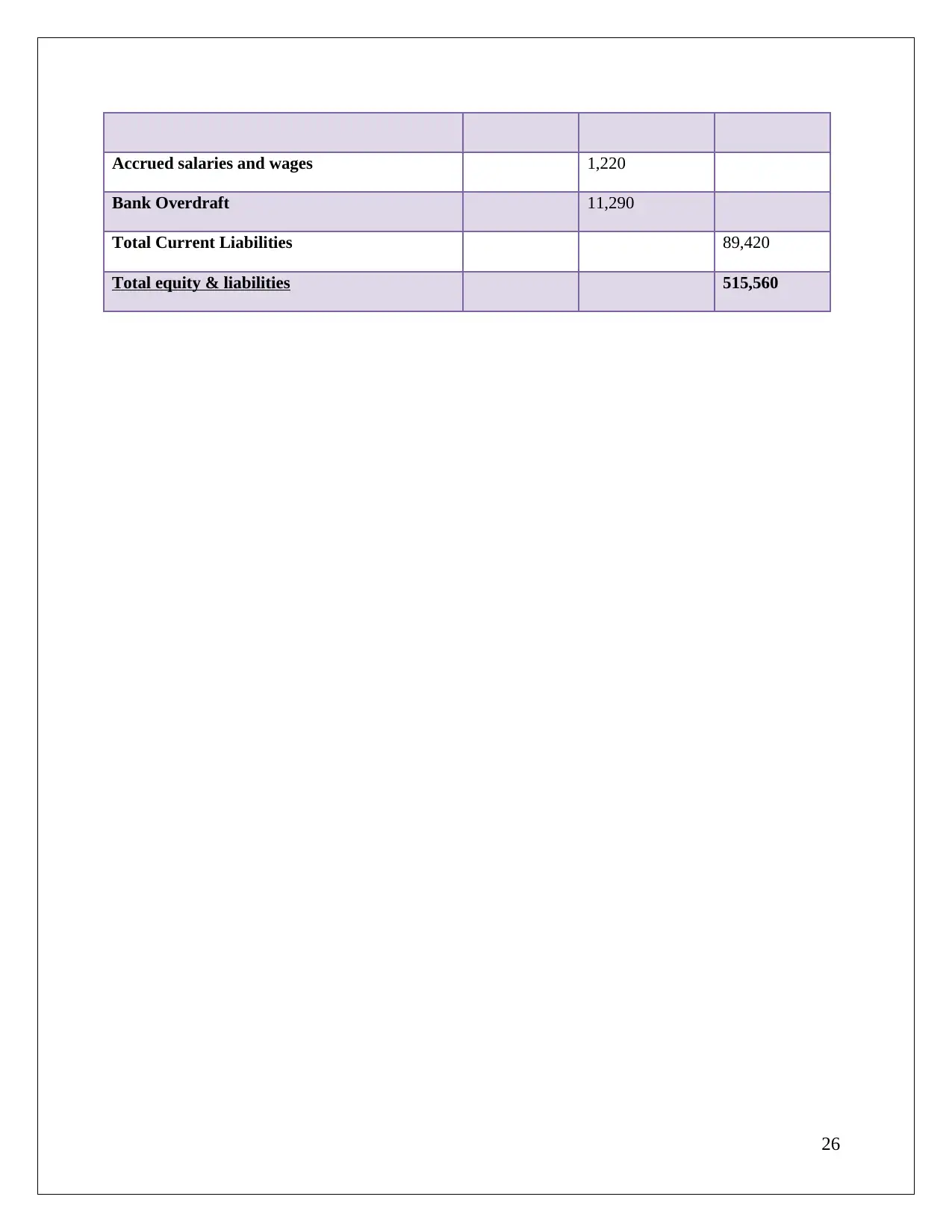
Accrued salaries and wages 1,220
Bank Overdraft 11,290
Total Current Liabilities 89,420
Total equity & liabilities 515,560
26
Bank Overdraft 11,290
Total Current Liabilities 89,420
Total equity & liabilities 515,560
26
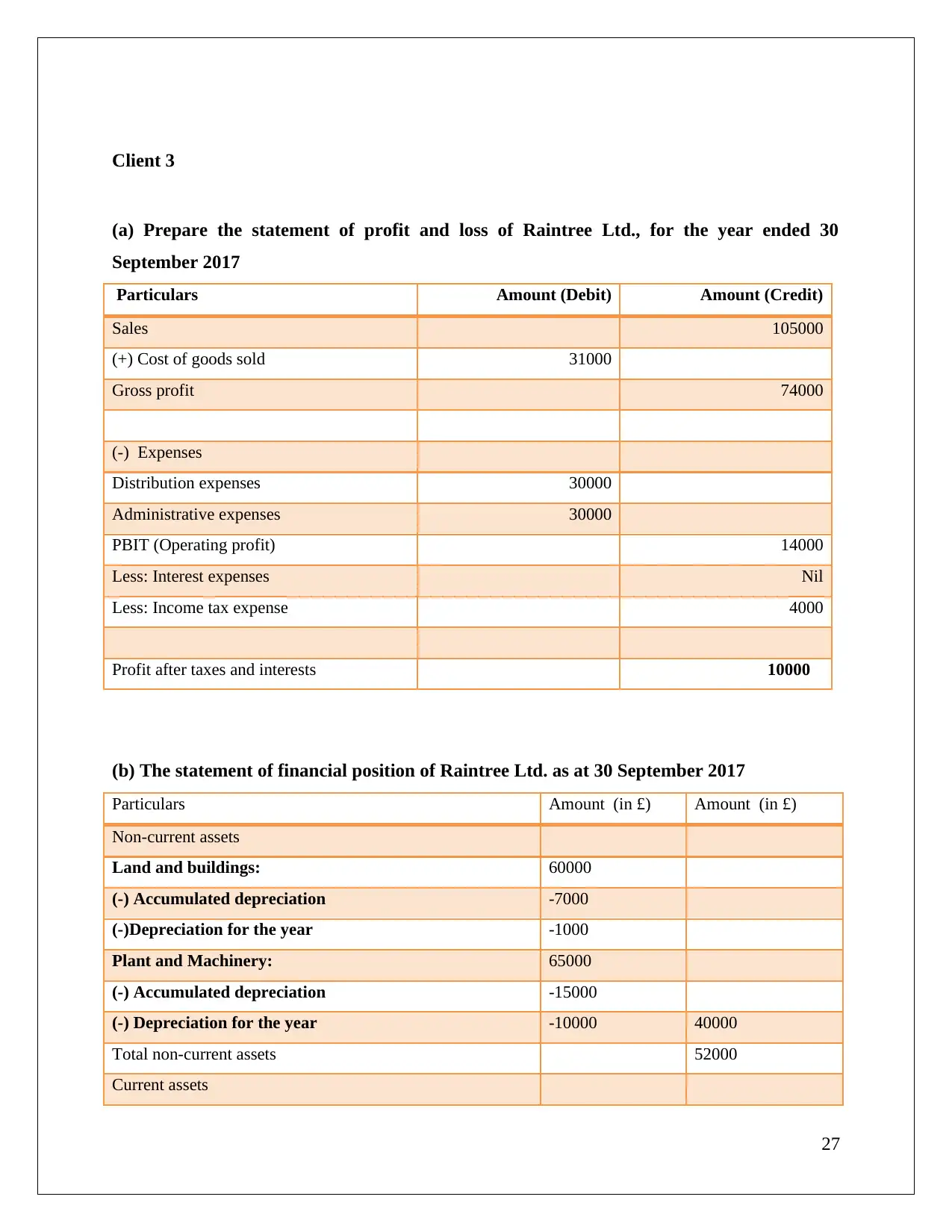
Client 3
(a) Prepare the statement of profit and loss of Raintree Ltd., for the year ended 30
September 2017
Particulars Amount (Debit) Amount (Credit)
Sales 105000
(+) Cost of goods sold 31000
Gross profit 74000
(-) Expenses
Distribution expenses 30000
Administrative expenses 30000
PBIT (Operating profit) 14000
Less: Interest expenses Nil
Less: Income tax expense 4000
Profit after taxes and interests 10000
(b) The statement of financial position of Raintree Ltd. as at 30 September 2017
Particulars Amount (in £) Amount (in £)
Non-current assets
Land and buildings: 60000
(-) Accumulated depreciation -7000
(-)Depreciation for the year -1000
Plant and Machinery: 65000
(-) Accumulated depreciation -15000
(-) Depreciation for the year -10000 40000
Total non-current assets 52000
Current assets
27
(a) Prepare the statement of profit and loss of Raintree Ltd., for the year ended 30
September 2017
Particulars Amount (Debit) Amount (Credit)
Sales 105000
(+) Cost of goods sold 31000
Gross profit 74000
(-) Expenses
Distribution expenses 30000
Administrative expenses 30000
PBIT (Operating profit) 14000
Less: Interest expenses Nil
Less: Income tax expense 4000
Profit after taxes and interests 10000
(b) The statement of financial position of Raintree Ltd. as at 30 September 2017
Particulars Amount (in £) Amount (in £)
Non-current assets
Land and buildings: 60000
(-) Accumulated depreciation -7000
(-)Depreciation for the year -1000
Plant and Machinery: 65000
(-) Accumulated depreciation -15000
(-) Depreciation for the year -10000 40000
Total non-current assets 52000
Current assets
27

Trade receivables 24000
Prepaid rent 3000
Inventories 18000
Total current assets 45000
Total Assets 137000
Non-current liabilities 0
Current liabilities
Accrued Administration salary 2000
Bank overdraft 15000
Corporation taxes 4000
Total payables 14000
Total current liabilities 35000
Capital
Share capital 50000
Share premium 20000
Profit and loss 10000
Retained earnings 22000
Total equities and liabilities 102000
(c) Explain the accounting concept of “consistency” and “prudence”
Consistency and prudence are two important accounting concepts. The consistency concept
states that accounting techniques that a company has adapted once should be consistently used in
future (Warren, 2015). On the contrary, the prudence concept states that the revenues of a
company must not be overstated while its expenses must not be understated.
(d) Briefly discuss the purpose of depreciation in formulating accounting statements and
illustrate two widely used methods of calculating it
As stated by Nobes (2015), purpose of depreciation in formulation of accounting statements is -
To match costs of the productive assets of a company
28
Prepaid rent 3000
Inventories 18000
Total current assets 45000
Total Assets 137000
Non-current liabilities 0
Current liabilities
Accrued Administration salary 2000
Bank overdraft 15000
Corporation taxes 4000
Total payables 14000
Total current liabilities 35000
Capital
Share capital 50000
Share premium 20000
Profit and loss 10000
Retained earnings 22000
Total equities and liabilities 102000
(c) Explain the accounting concept of “consistency” and “prudence”
Consistency and prudence are two important accounting concepts. The consistency concept
states that accounting techniques that a company has adapted once should be consistently used in
future (Warren, 2015). On the contrary, the prudence concept states that the revenues of a
company must not be overstated while its expenses must not be understated.
(d) Briefly discuss the purpose of depreciation in formulating accounting statements and
illustrate two widely used methods of calculating it
As stated by Nobes (2015), purpose of depreciation in formulation of accounting statements is -
To match costs of the productive assets of a company
28
Secure Best Marks with AI Grader
Need help grading? Try our AI Grader for instant feedback on your assignments.

To determine the correct value of assets after physical wear and tear
To determine a company’s correct financial position
To recognize a company’s actual asset value
29
To determine a company’s correct financial position
To recognize a company’s actual asset value
29
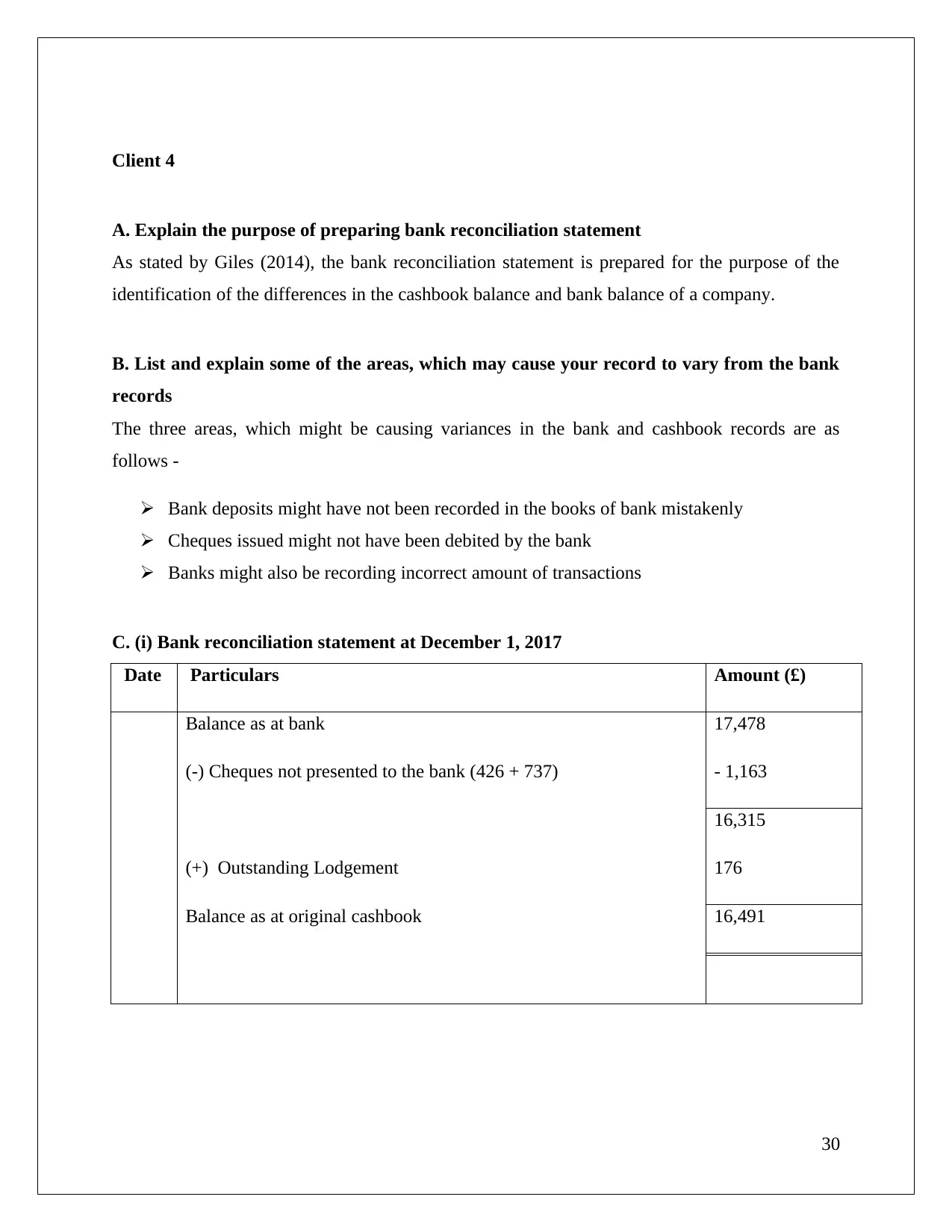
Client 4
A. Explain the purpose of preparing bank reconciliation statement
As stated by Giles (2014), the bank reconciliation statement is prepared for the purpose of the
identification of the differences in the cashbook balance and bank balance of a company.
B. List and explain some of the areas, which may cause your record to vary from the bank
records
The three areas, which might be causing variances in the bank and cashbook records are as
follows -
Bank deposits might have not been recorded in the books of bank mistakenly
Cheques issued might not have been debited by the bank
Banks might also be recording incorrect amount of transactions
C. (i) Bank reconciliation statement at December 1, 2017
Date Particulars Amount (£)
Balance as at bank 17,478
(-) Cheques not presented to the bank (426 + 737) - 1,163
16,315
(+) Outstanding Lodgement 176
Balance as at original cashbook 16,491
30
A. Explain the purpose of preparing bank reconciliation statement
As stated by Giles (2014), the bank reconciliation statement is prepared for the purpose of the
identification of the differences in the cashbook balance and bank balance of a company.
B. List and explain some of the areas, which may cause your record to vary from the bank
records
The three areas, which might be causing variances in the bank and cashbook records are as
follows -
Bank deposits might have not been recorded in the books of bank mistakenly
Cheques issued might not have been debited by the bank
Banks might also be recording incorrect amount of transactions
C. (i) Bank reconciliation statement at December 1, 2017
Date Particulars Amount (£)
Balance as at bank 17,478
(-) Cheques not presented to the bank (426 + 737) - 1,163
16,315
(+) Outstanding Lodgement 176
Balance as at original cashbook 16,491
30
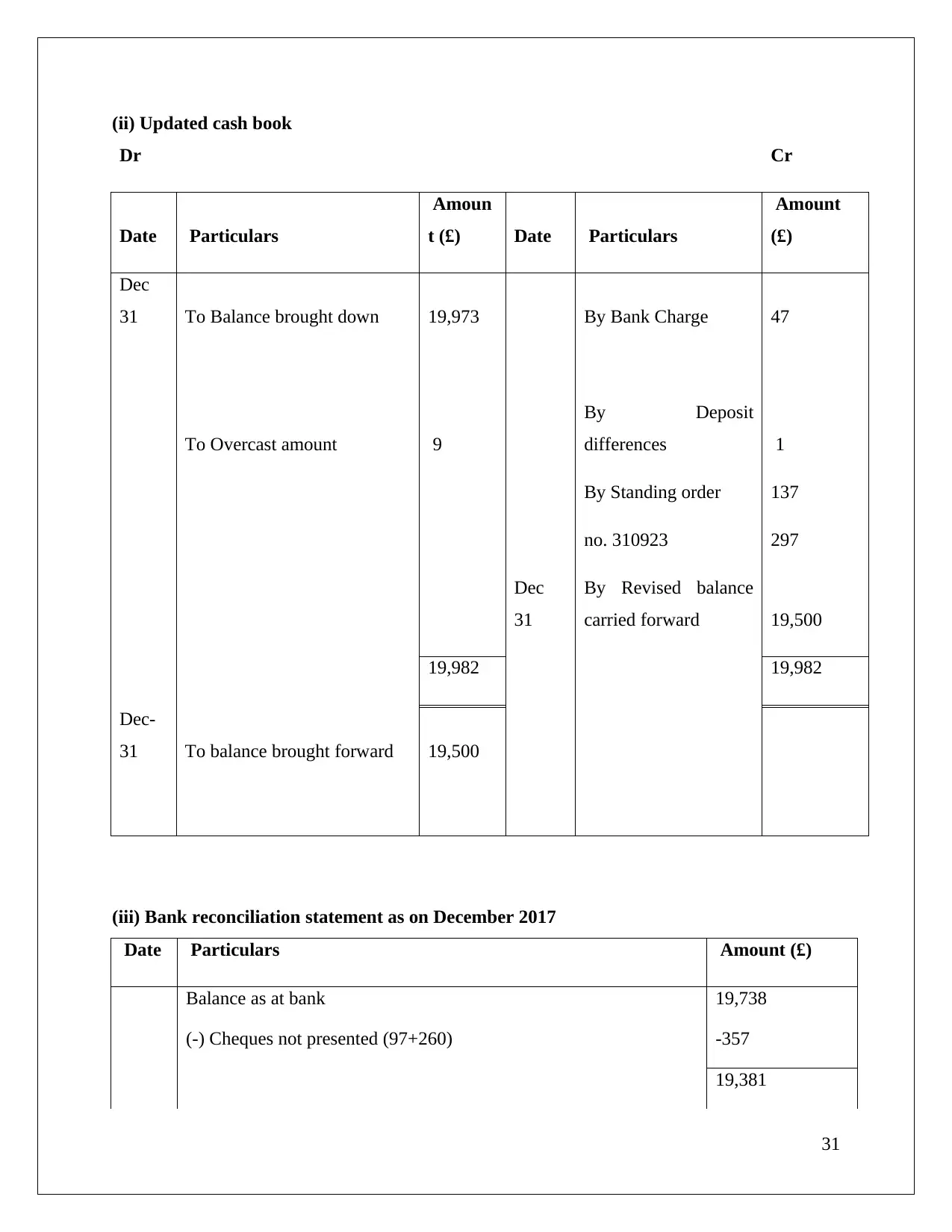
(ii) Updated cash book
Dr Cr
Date Particulars
Amoun
t (£) Date Particulars
Amount
(£)
Dec
31 To Balance brought down 19,973 By Bank Charge 47
To Overcast amount 9
By Deposit
differences 1
By Standing order 137
no. 310923 297
Dec
31
By Revised balance
carried forward 19,500
19,982 19,982
Dec-
31 To balance brought forward 19,500
(iii) Bank reconciliation statement as on December 2017
Date Particulars Amount (£)
Balance as at bank 19,738
(-) Cheques not presented (97+260) -357
19,381
31
Dr Cr
Date Particulars
Amoun
t (£) Date Particulars
Amount
(£)
Dec
31 To Balance brought down 19,973 By Bank Charge 47
To Overcast amount 9
By Deposit
differences 1
By Standing order 137
no. 310923 297
Dec
31
By Revised balance
carried forward 19,500
19,982 19,982
Dec-
31 To balance brought forward 19,500
(iii) Bank reconciliation statement as on December 2017
Date Particulars Amount (£)
Balance as at bank 19,738
(-) Cheques not presented (97+260) -357
19,381
31
Paraphrase This Document
Need a fresh take? Get an instant paraphrase of this document with our AI Paraphraser
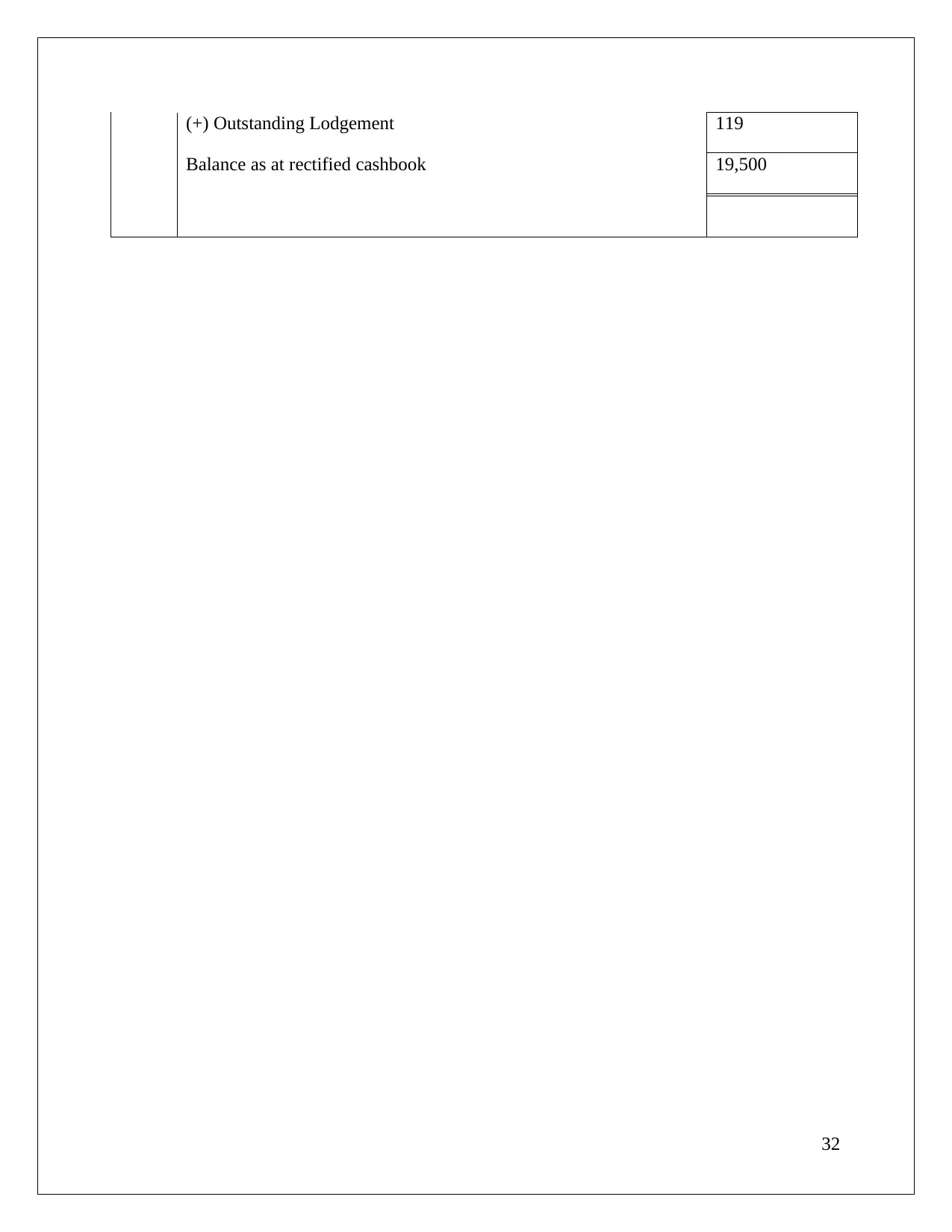
(+) Outstanding Lodgement 119
Balance as at rectified cashbook 19,500
32
Balance as at rectified cashbook 19,500
32
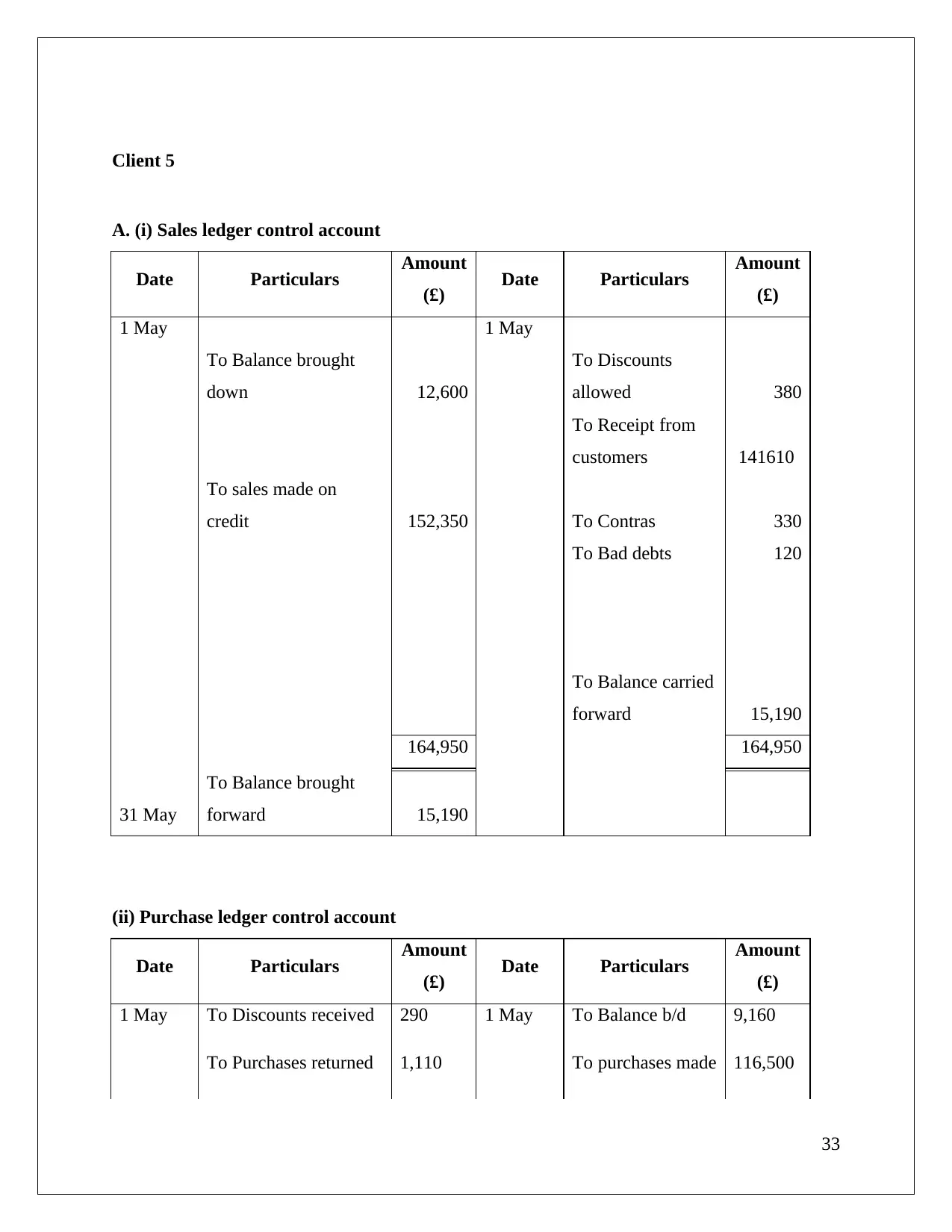
Client 5
A. (i) Sales ledger control account
Date Particulars Amount
(£) Date Particulars Amount
(£)
1 May 1 May
To Balance brought
down 12,600
To Discounts
allowed 380
To Receipt from
customers 141610
To sales made on
credit 152,350 To Contras 330
To Bad debts 120
To Balance carried
forward 15,190
164,950 164,950
31 May
To Balance brought
forward 15,190
(ii) Purchase ledger control account
Date Particulars Amount
(£) Date Particulars Amount
(£)
1 May To Discounts received 290 1 May To Balance b/d 9,160
To Purchases returned 1,110 To purchases made 116,500
33
A. (i) Sales ledger control account
Date Particulars Amount
(£) Date Particulars Amount
(£)
1 May 1 May
To Balance brought
down 12,600
To Discounts
allowed 380
To Receipt from
customers 141610
To sales made on
credit 152,350 To Contras 330
To Bad debts 120
To Balance carried
forward 15,190
164,950 164,950
31 May
To Balance brought
forward 15,190
(ii) Purchase ledger control account
Date Particulars Amount
(£) Date Particulars Amount
(£)
1 May To Discounts received 290 1 May To Balance b/d 9,160
To Purchases returned 1,110 To purchases made 116,500
33

on credit
To Payments made 101,010
To Refunds
received
To Contras 330 from suppliers 400
31 May
To Balance carried
forward 23,320
126,060 126,060
31 May
To Balance
brought forward 23,320
B. Explain the term “control account”
Control accounts are the accounts used in a company in order to record the balance of the
different subsidiary accounts of a company and are used for crosschecking them (Lim and Foo,
2017). Such an account is prepared for the maintenance of the correct balance in financial
statements and general ledger.
34
To Payments made 101,010
To Refunds
received
To Contras 330 from suppliers 400
31 May
To Balance carried
forward 23,320
126,060 126,060
31 May
To Balance
brought forward 23,320
B. Explain the term “control account”
Control accounts are the accounts used in a company in order to record the balance of the
different subsidiary accounts of a company and are used for crosschecking them (Lim and Foo,
2017). Such an account is prepared for the maintenance of the correct balance in financial
statements and general ledger.
34
Secure Best Marks with AI Grader
Need help grading? Try our AI Grader for instant feedback on your assignments.
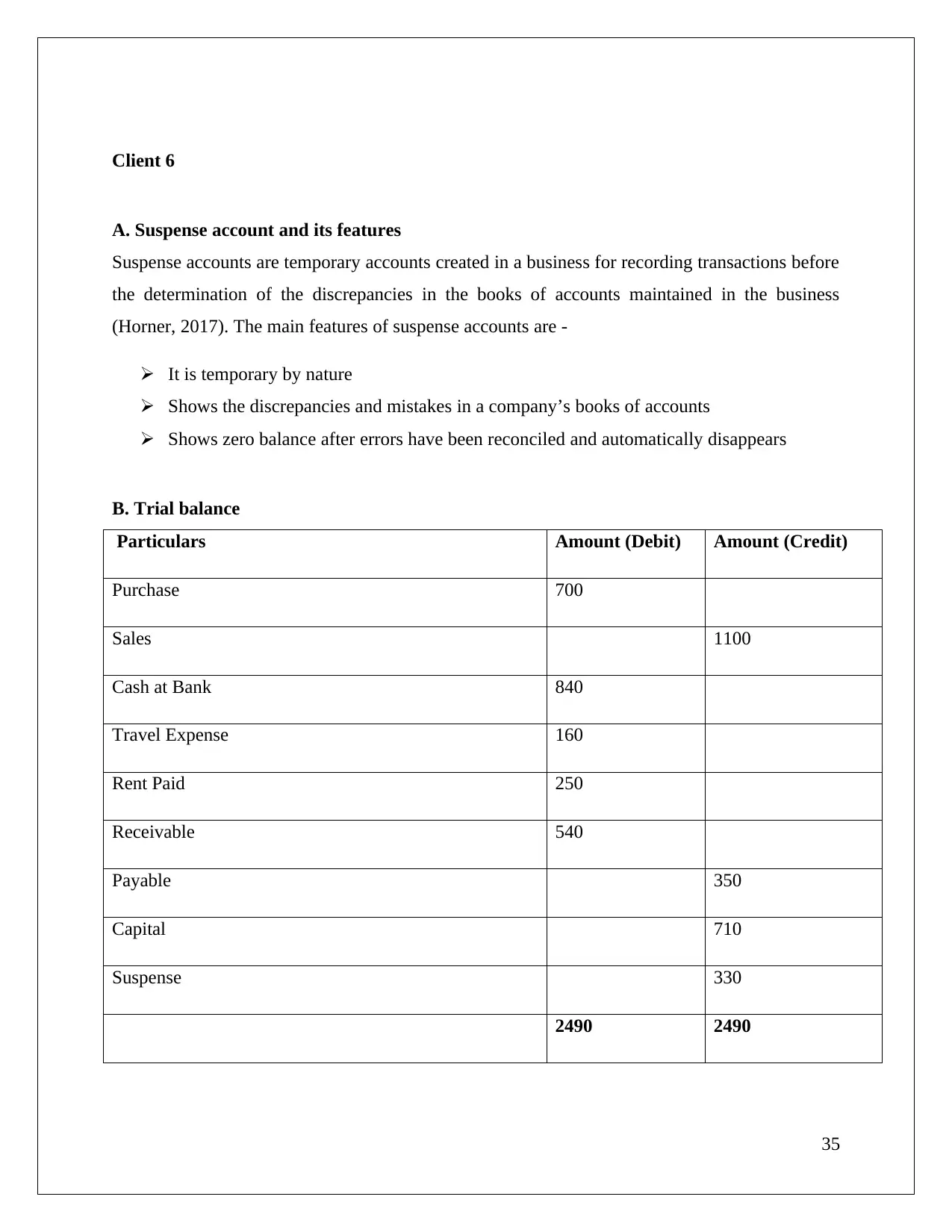
Client 6
A. Suspense account and its features
Suspense accounts are temporary accounts created in a business for recording transactions before
the determination of the discrepancies in the books of accounts maintained in the business
(Horner, 2017). The main features of suspense accounts are -
It is temporary by nature
Shows the discrepancies and mistakes in a company’s books of accounts
Shows zero balance after errors have been reconciled and automatically disappears
B. Trial balance
Particulars Amount (Debit) Amount (Credit)
Purchase 700
Sales 1100
Cash at Bank 840
Travel Expense 160
Rent Paid 250
Receivable 540
Payable 350
Capital 710
Suspense 330
2490 2490
35
A. Suspense account and its features
Suspense accounts are temporary accounts created in a business for recording transactions before
the determination of the discrepancies in the books of accounts maintained in the business
(Horner, 2017). The main features of suspense accounts are -
It is temporary by nature
Shows the discrepancies and mistakes in a company’s books of accounts
Shows zero balance after errors have been reconciled and automatically disappears
B. Trial balance
Particulars Amount (Debit) Amount (Credit)
Purchase 700
Sales 1100
Cash at Bank 840
Travel Expense 160
Rent Paid 250
Receivable 540
Payable 350
Capital 710
Suspense 330
2490 2490
35
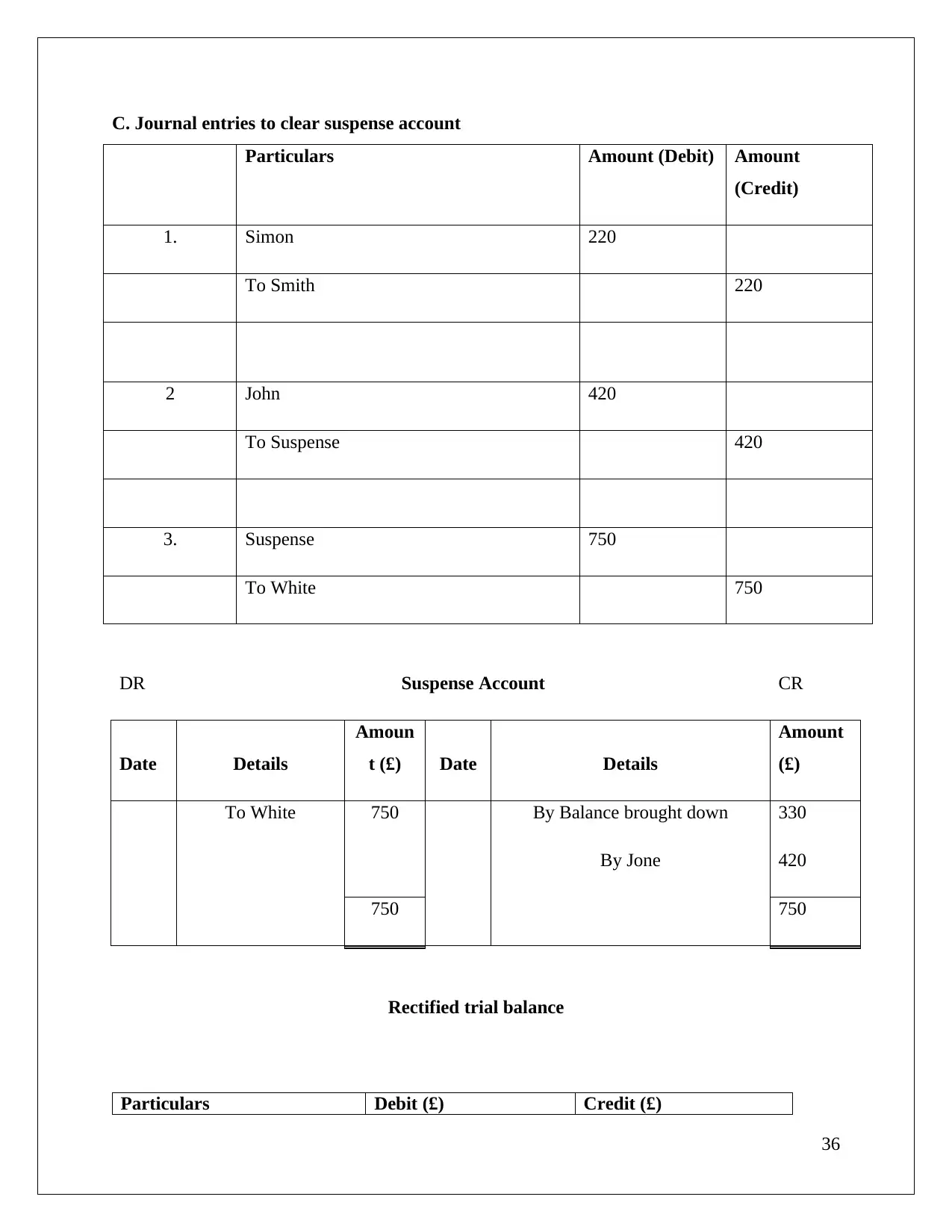
C. Journal entries to clear suspense account
Particulars Amount (Debit) Amount
(Credit)
1. Simon 220
To Smith 220
2 John 420
To Suspense 420
3. Suspense 750
To White 750
DR Suspense Account CR
Date Details
Amoun
t (£) Date Details
Amount
(£)
To White 750 By Balance brought down 330
By Jone 420
750 750
Rectified trial balance
Particulars Debit (£) Credit (£)
36
Particulars Amount (Debit) Amount
(Credit)
1. Simon 220
To Smith 220
2 John 420
To Suspense 420
3. Suspense 750
To White 750
DR Suspense Account CR
Date Details
Amoun
t (£) Date Details
Amount
(£)
To White 750 By Balance brought down 330
By Jone 420
750 750
Rectified trial balance
Particulars Debit (£) Credit (£)
36
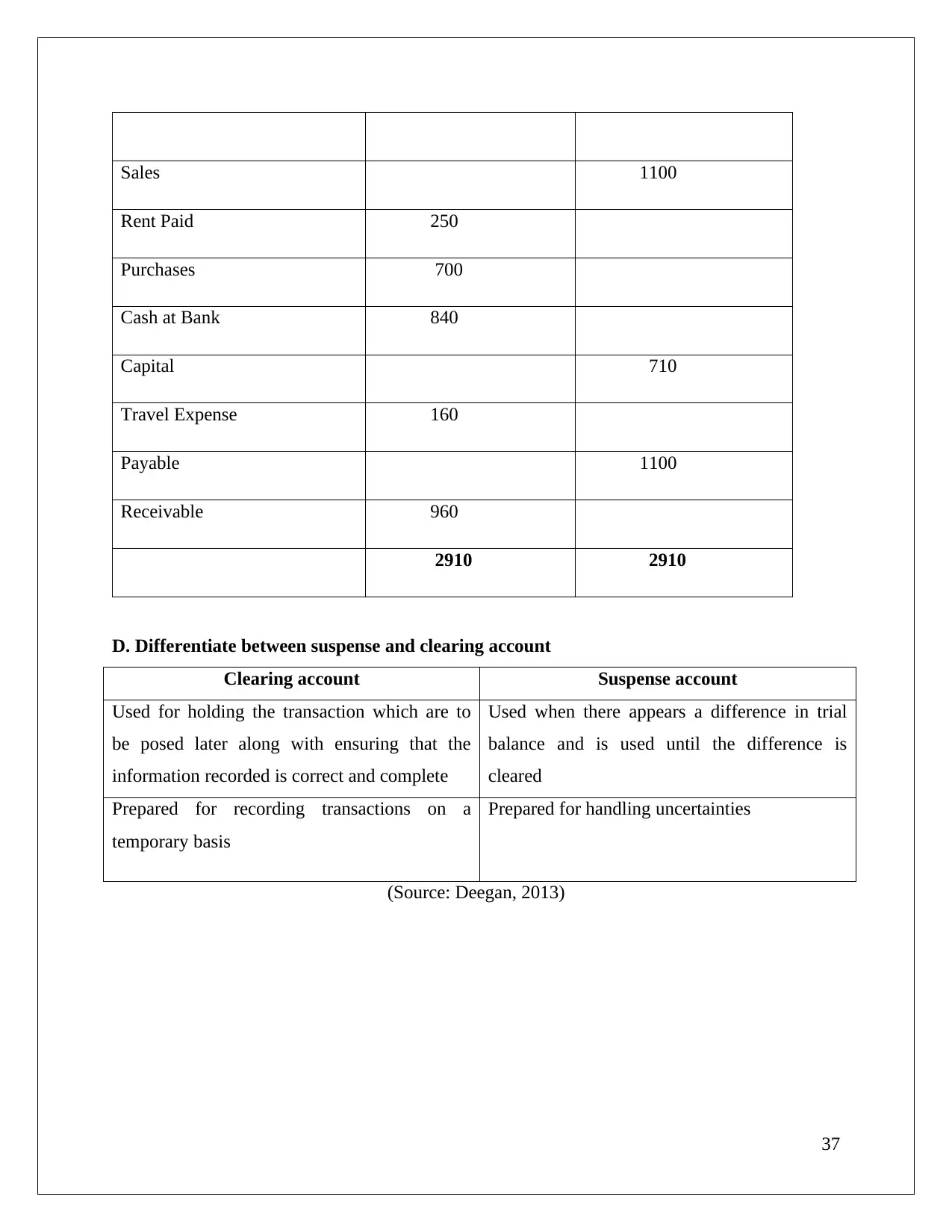
Sales 1100
Rent Paid 250
Purchases 700
Cash at Bank 840
Capital 710
Travel Expense 160
Payable 1100
Receivable 960
2910 2910
D. Differentiate between suspense and clearing account
Clearing account Suspense account
Used for holding the transaction which are to
be posed later along with ensuring that the
information recorded is correct and complete
Used when there appears a difference in trial
balance and is used until the difference is
cleared
Prepared for recording transactions on a
temporary basis
Prepared for handling uncertainties
(Source: Deegan, 2013)
37
Rent Paid 250
Purchases 700
Cash at Bank 840
Capital 710
Travel Expense 160
Payable 1100
Receivable 960
2910 2910
D. Differentiate between suspense and clearing account
Clearing account Suspense account
Used for holding the transaction which are to
be posed later along with ensuring that the
information recorded is correct and complete
Used when there appears a difference in trial
balance and is used until the difference is
cleared
Prepared for recording transactions on a
temporary basis
Prepared for handling uncertainties
(Source: Deegan, 2013)
37
Paraphrase This Document
Need a fresh take? Get an instant paraphrase of this document with our AI Paraphraser
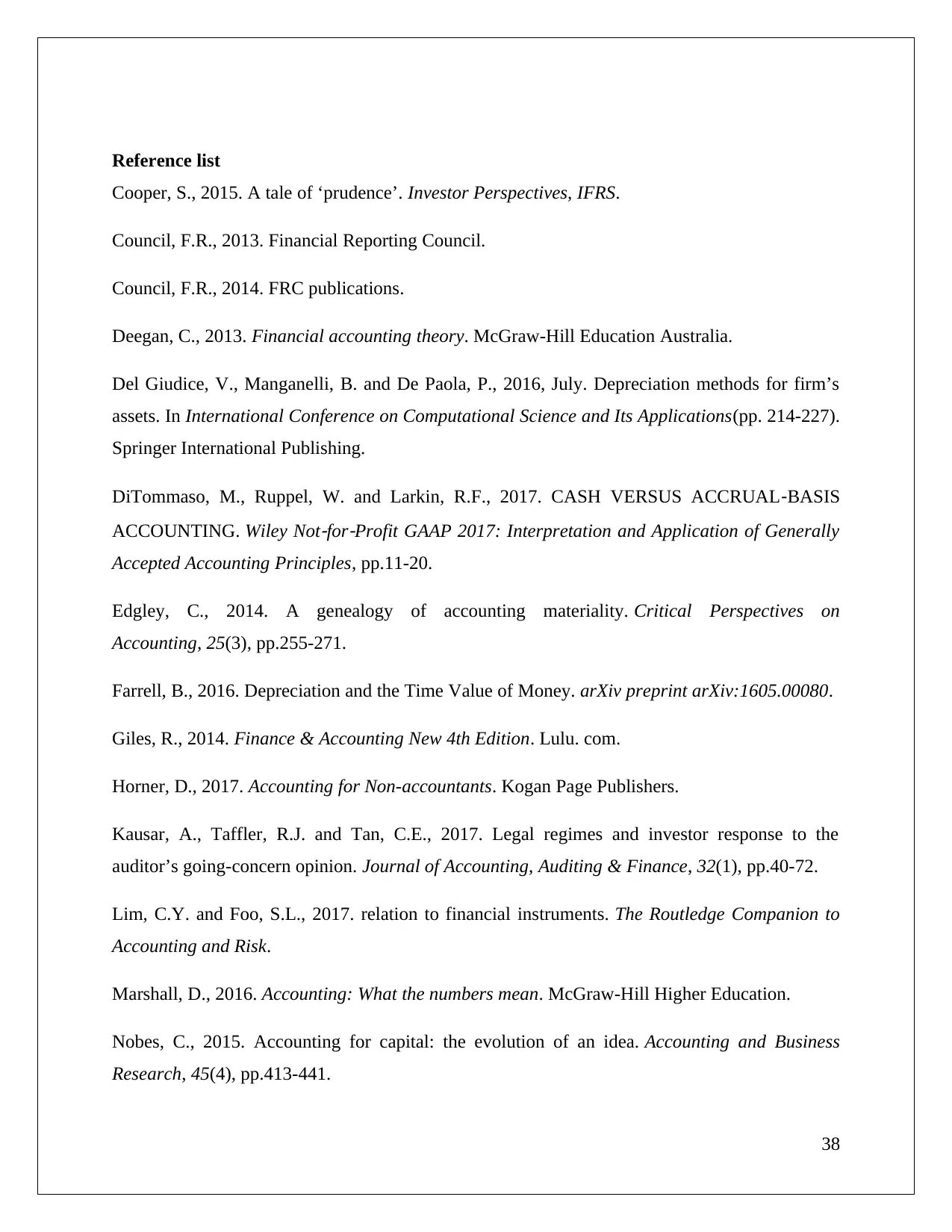
Reference list
Cooper, S., 2015. A tale of ‘prudence’. Investor Perspectives, IFRS.
Council, F.R., 2013. Financial Reporting Council.
Council, F.R., 2014. FRC publications.
Deegan, C., 2013. Financial accounting theory. McGraw-Hill Education Australia.
Del Giudice, V., Manganelli, B. and De Paola, P., 2016, July. Depreciation methods for firm’s
assets. In International Conference on Computational Science and Its Applications(pp. 214-227).
Springer International Publishing.
DiTommaso, M., Ruppel, W. and Larkin, R.F., 2017. CASH VERSUS ACCRUAL‐BASIS
ACCOUNTING. Wiley Not
‐for
‐Profit GAAP 2017: Interpretation and Application of Generally
Accepted Accounting Principles, pp.11-20.
Edgley, C., 2014. A genealogy of accounting materiality. Critical Perspectives on
Accounting, 25(3), pp.255-271.
Farrell, B., 2016. Depreciation and the Time Value of Money. arXiv preprint arXiv:1605.00080.
Giles, R., 2014. Finance & Accounting New 4th Edition. Lulu. com.
Horner, D., 2017. Accounting for Non-accountants. Kogan Page Publishers.
Kausar, A., Taffler, R.J. and Tan, C.E., 2017. Legal regimes and investor response to the
auditor’s going-concern opinion. Journal of Accounting, Auditing & Finance, 32(1), pp.40-72.
Lim, C.Y. and Foo, S.L., 2017. relation to financial instruments. The Routledge Companion to
Accounting and Risk.
Marshall, D., 2016. Accounting: What the numbers mean. McGraw-Hill Higher Education.
Nobes, C., 2015. Accounting for capital: the evolution of an idea. Accounting and Business
Research, 45(4), pp.413-441.
38
Cooper, S., 2015. A tale of ‘prudence’. Investor Perspectives, IFRS.
Council, F.R., 2013. Financial Reporting Council.
Council, F.R., 2014. FRC publications.
Deegan, C., 2013. Financial accounting theory. McGraw-Hill Education Australia.
Del Giudice, V., Manganelli, B. and De Paola, P., 2016, July. Depreciation methods for firm’s
assets. In International Conference on Computational Science and Its Applications(pp. 214-227).
Springer International Publishing.
DiTommaso, M., Ruppel, W. and Larkin, R.F., 2017. CASH VERSUS ACCRUAL‐BASIS
ACCOUNTING. Wiley Not
‐for
‐Profit GAAP 2017: Interpretation and Application of Generally
Accepted Accounting Principles, pp.11-20.
Edgley, C., 2014. A genealogy of accounting materiality. Critical Perspectives on
Accounting, 25(3), pp.255-271.
Farrell, B., 2016. Depreciation and the Time Value of Money. arXiv preprint arXiv:1605.00080.
Giles, R., 2014. Finance & Accounting New 4th Edition. Lulu. com.
Horner, D., 2017. Accounting for Non-accountants. Kogan Page Publishers.
Kausar, A., Taffler, R.J. and Tan, C.E., 2017. Legal regimes and investor response to the
auditor’s going-concern opinion. Journal of Accounting, Auditing & Finance, 32(1), pp.40-72.
Lim, C.Y. and Foo, S.L., 2017. relation to financial instruments. The Routledge Companion to
Accounting and Risk.
Marshall, D., 2016. Accounting: What the numbers mean. McGraw-Hill Higher Education.
Nobes, C., 2015. Accounting for capital: the evolution of an idea. Accounting and Business
Research, 45(4), pp.413-441.
38

Penman, S., 2016. Conservatism as a Defining Principle for Accounting. The Japanese
Accounting Review, pp.6-2016.
Picker, R., Clark, K., Dunn, J., Kolitz, D., Livne, G., Loftus, J. and Van der Tas, L.,
2016. Applying international financial reporting standards. John Wiley & Sons.
Warren, C.M., 2016. The impact of International Accounting Standards Board
(IASB)/International Financial Reporting Standard 16 (IFRS 16). Property Management, 34(3).
Warren, J., 2015. Conventionalism, consistency, and consistency sentences. Synthese, 192(5),
pp.1351-1371.
Williams, J., 2014. Financial accounting. McGraw-Hill Higher Education.
39
Accounting Review, pp.6-2016.
Picker, R., Clark, K., Dunn, J., Kolitz, D., Livne, G., Loftus, J. and Van der Tas, L.,
2016. Applying international financial reporting standards. John Wiley & Sons.
Warren, C.M., 2016. The impact of International Accounting Standards Board
(IASB)/International Financial Reporting Standard 16 (IFRS 16). Property Management, 34(3).
Warren, J., 2015. Conventionalism, consistency, and consistency sentences. Synthese, 192(5),
pp.1351-1371.
Williams, J., 2014. Financial accounting. McGraw-Hill Higher Education.
39
1 out of 39
Related Documents
Your All-in-One AI-Powered Toolkit for Academic Success.
+13062052269
info@desklib.com
Available 24*7 on WhatsApp / Email
![[object Object]](/_next/static/media/star-bottom.7253800d.svg)
Unlock your academic potential
© 2024 | Zucol Services PVT LTD | All rights reserved.





